Consumer Research on the Safe Handling Instructions Label for Raw and Partially Cooked Meat and Poultry Products and Labeling Statements for Ready-to-Eat and Not-Ready-to-Eat Products
Consumer Research on the Safe Handling Instructions Label for Raw and Partially Cooked Meat and Poultry Products and Labeling Statements for Ready-to-Eat and Not-Ready-to-Eat Products
Appendix B_Combined_Web Surveys_10_12_18
Consumer Research on the Safe Handling Instructions Label for Raw and Partially Cooked Meat and Poultry Products and Labeling Statements for Ready-to-Eat and Not-Ready-to-Eat Products
OMB: 0583-0177
Appendix B:
Experimental
Web-Based Study Instrument—English and Spanish
Appendix B1:
Experimental Web-Based Study Instrument—English
[SP]
[Prompt if Refused]
S1. What language would you prefer to take this survey in? / ¿En qué idioma prefiere llenar esta encuesta?
1. English/Inglés
2. Spanish/Español
[DISPLAY 1]
RTI International is conducting this survey on cooking with funding from the U.S. Department of Agriculture (USDA). Your participation in this study is completely voluntary. All your answers will be kept private. In our experience, answering the survey questions involves no more risk of harm than you would experience in everyday life.
If you have any questions about the study, you may contact Katherine Kosa of RTI at 1‑800‑334‑8571, extension 23901 or by email at kkosa@rti.org. If you have any questions about your rights as a study participant, you may contact RTI’s Office of Research Protection at 1-866-214-2043 or by email at orpe@rti.org.
[DISPLAY 2]
According to the Paperwork Reduction Act of 1995, an agency may not conduct or sponsor, and a person is not required to respond to, a collection of information unless it displays a valid OMB control number. The valid OMB control number for this information collection is 0583-XXXX and the expiration date is xx/xx/xxxx. The time required to complete this information collection is estimated to average 20 minutes per response, including the time for reviewing instructions, searching existing data sources, gathering and maintaining the data needed, and completing and reviewing the collection of information.
[DISPLAY 3]
The first questions ask about you and your cooking experience.
[SP]
[Prompt if Refused]
S2. Which of the following categories describes your age?
1. Under 18
2. 18 to 24
3. 25 to 34
4. 35 to 44
5. 45 to 54
6. 55 to 64
7. 65 to 74
8. 75 or older
[Terminate if S2=1 or Refused]
[SP]
[Prompt if Refused]
S3. How many times per week do you cook raw meat or poultry at home?
1. Less than once a week
2. Once a week
3. Twice a week
3. Three times a week
4. Four or more times a week
[Terminate if S3=1 or Refused]
[SP]
[Prompt if Refused]
S5. Have you cooked or worked professionally in a food preparation setting in the past 5 years?
1. Yes
2. No
[Terminate if S5=1 or Refused]
[SP]
[Prompt if Refused]
S6. Have you received any type of food safety training, such as ServSafe, in the past 5 years?
1. Yes
2. No
[Terminate if S6=1 or REFUSED]
[SP]
D1. What is the highest grade or level of school you have completed? Please select one answer.
1. Less than 9th grade
2. 9th to 12th grade, NO DIPLOMA
3. High school graduate—DIPLOMA or GED
4. Vocational training
5. Some college or associate’s degree
6. Bachelor’s degree
7. Graduate or professional degree
8. Don’t know
9. Prefer not to answer
[SP]
D2. Please enter your zip code. [5 DIGITS] [RECODE INTO REGIONS BELOW]
HIDDEN: U.S. Regions:
Northeast (ME, NH, VT, MA, RI, CT, NY, NJ, PA)
Midwest (WI, IL, MI, IN, OH, ND, SD, NE, KS, MN, IA, MO)
South (KY, TN, MS, AL, FL, GA, SC, NC, VA, WV, DC, MD, DE, TX, OK, AR, LA)
West (MT, ID, WY, NV, UT, CO, AZ, NM, WA, OR, CA, AK, HI)
[SP]
D3. Do you identify as ….?
1. Female
2. Male
3. Other
4. Prefer not to answer
[SP]
D4. Are you…?
1. Hispanic or Latino
2. Not Hispanic or Latino
[MP]
D5. What is your race? Select one or more answers.
1. American Indian or Alaska Native
2. Asian
3. Black or African American
4. Native Hawaiian or other Pacific Islander
5. White
[DISPLAY 4]
On the next screen, you will see a food label. You will see the label for about 15 seconds. Carefully review the information on the label because we are going to ask you a few questions about what you saw.
[DISPLAY FOOD PACKAGE- FILENAME- PackageA.jpg] – 15 seconds
[SP]
2. Did you see the words “Nutrition Facts” on the food package?
1. Yes
2. No
[IF Q2=1]
[SP]
2a. How sure are you that you saw the words “Nutrition Facts” on the food package?
1. Not at all sure
2. –
3. –
4. –
5. –
6. –
7. Very sure
[IF Q2=2]
[SP]
2b. How sure are you that you did NOT see the words “Nutrition Facts” on the food package?
1. Not at all sure
2. –
3. –
4. –
5. –
6. –
7. Very sure
[SP]
3. Did you see the phrase “All Natural” on the food package?
1. Yes
2. No
[IF Q3=1]
[SP]
3a. How sure are you that you saw the phrase “All Natural” on the food package?
1. Not at all sure
2. –
3. –
4. –
5. –
6. –
7. Very sure
[IF Q3=2]
[SP]
3b. How sure are you that you did NOT see the phrase “All Natural” on the food package?
1. Not at all sure
2. –
3. –
4. –
5. –
6. –
7. Very sure
[SP]
4. Did you see the phrase “Keep Frozen” on the food package?
1. Yes
2. No
[IF Q4=1]
[SP]
4a. How sure are you that you saw the phrase “Keep Frozen” on the food package?
1. Not at all sure
2. –
3. –
4. –
5. –
6. –
7. Very sure
[IF Q4=2]
[SP]
4b. How sure are you that you did NOT see the phrase “Keep Frozen” on the food package?
1. Not at all sure
2. –
3. –
4. –
5. –
6. –
7. Very sure
[DISPLAY 4A]
Next, you will see another food label. You will see the label for about 15 seconds. Carefully review the information on the label because we are going to ask you a few questions about what you saw.
[DISPLAY FOOD PACKAGE- FILENAME- PackageB.jpg] – 15 seconds
[NOTE: As described in Part B of the OMB Supporting Statement, respondents will be randomly assigned to view one of 27 versions of the SHI label (i.e., 27 conditions) during the Web-based experiment. For illustration purposes, the current SHI label is shown in the screenshots. The “hits” in the following questions will reflect the version of the SHI label viewed by the respondent, what is shown in the “hits” will vary for the 27 conditions. The “misses” will be text/symbols that are not on the SHI label viewed by the respondent and will be constant for the 27 conditions.]
[RANDOMIZE ORDER OF Q6-Q13]
[SP] (hit1 – title of shi)
6. Did you see the phrase “Safe Handling Instructions” on the food package?
1. Yes
2. No
[IF Q6=1]
[SP]
6a. How sure are you that you saw the phrase “Safe Handling Instructions” on the food package?
1. Not at all sure
2. –
3. –
4. –
5. –
6. –
7. Very sure
[IF Q6=2]
[SP]
6b. How sure are you that you did NOT see the phrase “Safe Handling Instructions” on the food package?
1. Not at all sure
2. –
3. –
4. –
5. –
6. –
7. Very sure
[DISPLAY frying pan ICON for next 3 questions] – FILENAME – fryingpan.jpg
[SP] (hit2) – image for cook message
7. Did you see this image on the food package?
1. Yes
2. No
[IF Q7=1]
[DISPLAY frying pan ICON]
[SP]
7a. How sure are you that you saw this image on the food package?
1. Not at all sure
2. –
3. –
4. –
5. –
6. –
7. Very sure
[IF Q7=2]
[DISPLAY frying pan ICON]
[SP]
7b. How sure are you that you did NOT see this image on the food package?
1. Not at all sure
2. –
3. –
4. –
5. –
6. –
7. Very sure
[DISPLAY food thermometer ICON] hit3 – FILENAME – thermometer.jpg
[SP] (HIT3 – image for wash surfaces message)
8. Did you see this image on the food package?
1. Yes
2. No
[IF Q8=1]
[DISPLAY food thermometer ICON]
[SP]
8a. How sure are you that you saw this image on the food package?
1. Not at all sure
2. –
3. –
4. –
5. –
6. –
7. Very sure
[SP]
[IF Q8=2]
[DISPLAY food thermometer ICON]
[SP]
8b. How sure are you that you did NOT see this image on the food package?
1. Not at all sure
2. –
3. –
4. –
5. –
6. –
7. Very sure
[SP] – hit 4 (text for cook message)
9. Did you see the statement “Cook thoroughly” on the food package?
1. Yes
2. No
[IF Q9=1]
[SP]
9a. How sure are you that you saw the statement “Cook thoroughly” on the food package?
1. Not at all sure
2. –
3. –
4. –
5. –
6. –
7. Very sure
[IF Q9=2]
[SP]
9b. How sure are you that you did NOT see the statement “Cook thoroughly” on the food package?
1. Not at all sure
2. –
3. –
4. –
5. –
6. –
7. Very sure
[SP] – miss1
10. Did you see the statement “No GMOs” on the food package?
1. Yes
2. No
[IF Q10=1]
[SP]
10a. How sure are you that you saw the statement “No GMOs” on the food package?
1. Not at all sure
2. –
3. –
4. –
5. –
6. –
7. Very sure
[IF Q10=2]
[SP]
10b. How sure are you that you did NOT see the statement “No GMOs” on the food package?
1. Not at all sure
2. –
3. –
4. –
5. –
6. –
7. Very sure
[DISPLAY (GF)] – miss2 - - FILENAME – GF.jpg
[SP]
11. Did you see this image on the food package?
1. Yes
2. No
[IF Q11=1]
[DISPLAY (GF)]
[SP]
11a. How sure are you that you saw this image on the food package?
1. Not at all sure
2. –
3. –
4. –
5. –
6. –
7. Very sure
[IF Q11=2]
[DISPLAY (GF)]
[SP]
11b. How sure are you that you did NOT see this image on the food package?
1. Not at all sure
2. –
3. –
4. –
5. –
6. –
7. Very sure
[SP] -miss3
12 Did you see the words “Made in USA” on the food package?
1. Yes
2. No
[SP]
[IF Q12=1]
12a. How sure are you that you saw the words “Made in USA” on the food package?
1. Not at all sure
2. –
3. –
4. –
5. –
6. –
7. Very sure
[SP]
[IF Q12=2]
12b. How sure are you that you did NOT see the words “Made in USA” on the food package?
1. Not at all sure
2. –
3. –
4. –
5. –
6. –
7. Very sure
[DISPLAY Grill ICON] – miss4 – FILENAME grill.jpg
[SP]
13 Did you see this image on the food package?
1. Yes
2. No
[IF Q13=1]
[DISPLAY grill ICON]
[SP]
13a. How sure are you that you saw this image on the food package?
1. Not at all sure
2. –
3. –
4. –
5. –
6. –
7. Very sure
[IF Q13=2]
[DISPLAY grill ICON]
[SP]
13b. How sure are you that you did NOT see this image on the food package?
1. Not at all sure
2. –
3. –
4. –
5. –
6. –
7. Very sure
[DISPLAY Package Silhouette]
14. This gray box represents the food label you just saw. Use your mouse to POINT to the spot where you saw information about how to safely prepare this food product and then DOUBLE CLICK.
44. We are testing new warning messages that tell people about the dangers of foodborne illness. Please rank the five messages shown below. Rank the best message as a “1”, the second-best message as a “2” and so on. Please drag and drop each option onto one of the choices below.
[RANDOMIZE MESSAGES]
Raw meat and poultry may contain bacteria that could cause illness if not handled or cooked safely. Follow these instructions to avoid illness. To prevent potential illness, follow these instructions for safely handling and cooking of this product. Raw meat and poultry may contain bacteria that could cause illness if not handled or cooked safely. Follow these instructions to prevent serious illness and long-term health problems for you and your family. Raw meat and poultry may contain bacteria that could cause illness if not handled or cooked safely. Millions of people get sick each year. Follow these instructions to prevent illness. Raw meat and poultry may contain bacteria that could cause illness if not handled or cooked safely. Millions of people get sick each year. Follow these instructions to prevent serious illness and long-term health problems for you and your family. |
[DISPLAY 8]
The next set of questions ask about a different topic. For these questions, indicate how much you think each statement sounds like you.
[RANDOMIZE QUESTIONS 28 THRU 36]
[SP]
28. How much do you agree this statement sounds like you?
When I try to do projects on my own, I’m afraid I will make a worse mess of them than if I had just left them alone.
1. Not at all like me
2. –
3. –
4. –
5. –
6. –
7. A lot like me
[SP]
29. How much do you agree this statement sounds like you?
I always follow manufacturer’s warnings against removing the backplates on products.
1. Not at all like me
2. –
3. –
4. –
5. –
6. –
7. A lot like me
[SP]
30. How much do you agree this statement sounds like you?
When I try to do projects on my own, without exact directions, they usually work out really well.
1. Not at all like me
2. –
3. –
4. –
5. –
6. –
7. A lot like me
[SP]
31. How much do you agree this statement sounds like you?
I find very little instruction is needed to use a product similar to one I’m already familiar with.
1. Not at all like me
2. –
3. –
4. –
5. –
6. –
7. A lot like me
[SP]
32. How much do you agree this statement sounds like you?
I’m afraid to buy a product I don’t know how to use.
1. Not at all like me
2. –
3. –
4. –
5. –
6. –
7. A lot like me
[SP]
33. How much do you agree this statement sounds like you?
I’m uncomfortable working on projects different from types I’m accustomed to.
1. Not at all like me
2. –
3. –
4. –
5. –
6. –
7. A lot like me
[SP]
34. How much do you agree this statement sounds like you?
I always follow manufacturer’s warnings regarding how to use a product.
1. Not at all like me
2. –
3. –
4. –
5. –
6. –
7. A lot like me
[SP]
35. How much do you agree this statement sounds like you?
If a product comes in an assembled and an unassembled form, I always buy the assembled form, even though it costs a little more.
1. Not at all like me
2. –
3. –
4. –
5. –
6. –
7. A lot like me
[SP]
36. How much do you agree this statement sounds like you?
I like to improvise when I cook.
1. Not at all like me
2. –
3. –
4. –
5. –
6. –
7. A lot like me
[DISPLAY 9]
You are almost done with the survey. This last set of questions is about you.
[MP]
37. Are you or any of the members of your household…?
1. 60 years of age or older
2. 5 years of age or younger
3. Pregnant
4. Diagnosed with an allergy to any food or ingredient
5. Diagnosed with diabetes or kidney disease
6. Diagnosed with a condition that weakens the immune system, such as cancer, HIV, or AIDS; recipient of a transplant; or receiving treatments, such as chemotherapy, radiation, or special drugs or medications to treat these conditions
7. None of the above – EXCLUSIVE
[DISPLAY SHI] - – FILENAME OldSHI.jpg
[SP]
38. Have you seen this before?
1. Yes
2. No
3. Not sure
[IF Q38=1]
[MP]
[DISPLAY SHI]
39. Where did you see it?
1. On a restaurant to-go package
2. In a public service announcement (PSA)
3. On a food package
4. In a cookbook
5. Can’t recall – EXCLUSIVE
[MP]
[Randomize response items]
40. Which of the following items do you have in your kitchen?
1. Can opener
2. Food thermometer
3. Turkey baster
4. Potato peeler
5. Spatula
6. Garlic press
7. None of the above – EXCLUSIVE
[SP]
41. In the past year, have you or has anyone in your household had any kind of illness that you thought might have been caused by eating unsafe food?
1. Yes
2. No
3. Not sure
[IF Q41=1]
[MP]
42. Sometimes people get sick enough from eating unsafe food to go to the doctor, and the doctor may do testing. Did a doctor or other health professional do any tests to confirm that your illness was caused by eating unsafe food?
1. No – EXCLUSIVE
2. Yes, blood test
3. Yes, stool test
4. Yes, but some other type of test
5. Can’t recall – EXCLUSIVE
6. Prefer Not to Answer – EXCLUSIVE
[SP]
43. If you were preparing a new product for the first time at home and had a question about how to prepare it, which would you most likely do?
1. Call the 1-800 number on the label to get more information
2. Go to the Web site address on the label to get more information
3. None of the above
[DISPLAY 10]
You have answered all the questions.
Thank you for completing the survey!
Appendix B2:
Experimental Web-Based Study Instrument—Spanish
[SP]
[Prompt if Refused]
S1. What language would you prefer to take this survey in? / ¿En qué idioma prefiere llenar esta encuesta?
1. English/Inglés
2. Spanish/Español
[DISPLAY 1]
RTI International está realizando una encuesta sobre cocina patrocinado por Departamento de Agricultura de los Estados Unidos. (USDA, por sus siglas en inglés). Su participación en este estudio es completamente voluntaria. Sus respuestas permanecerán confidenciales. En nuestra experiencia, responder las preguntas de la encuesta no implica mayor riesgo que el que experimentaría en la vida diaria.
Si tiene alguna pregunta sobre la encuesta, puede ponerse en contacto con Katherine Kosa de RTI al 1-800-334-8571, extensión 23901 o por correo electrónico a kkosa@rti.org. Si tiene alguna pregunta acerca de sus derechos como participante en un estudio, puede ponerse en contacto con la Oficina para la Protección de Participantes en Estudios de RTI al 1-866-214-2043 o por correo electrónico a orpe@rti.org.
[DISPLAY 2]
De conformidad con la Ley de Reducción de Trámites de 1995, una agencia no puede realizar ni patrocinar, y una persona no está obligada a responder a una recopilación de información a menos de que muestre un número de control válido de la Oficina de Administración y Presupuesto (OMB, por sus siglas en inglés). El número de control válido de la OMB para esta recopilación de información es 0583-XXXX y la fecha de vencimiento es xx/xx/xxxx. El tiempo necesario para completar esta recopilación de información se calcula en un promedio de 20 minutos por respuesta, incluido el tiempo para revisar las instrucciones, buscar fuentes de datos existentes, reunir y mantener los datos necesarios, y responder y revisar la recopilación de información.
[DISPLAY 3]
Las primeras preguntas son acerca de usted y su experiencia al cocinar.
[SP]
[Prompt if Refused]
S2. ¿Cuál de las siguientes categorías describe su edad?
Menos de 18 años
Entre 18 y 24 años
Entre 25 y 34 años
Entre 35 y 44 años
Entre 45 y 54 años
Entre 55 y 64 años
Entre 65 y 74 años
75 años o más
[Terminate If S2=1 or refused]
[SP]
[Prompt if Refused]
S3. ¿Cuántas veces a la semana cocina carne o aves crudas en su hogar?
Menos de una vez a la semana
Una vez a la semana
Dos veces a la semana
Tres veces a la semana
Cuatro o más veces a la semana
[Terminate If S3=1 or refused]
[SP]
[Prompt if Refused]
S5. ¿Ha cocinado o trabajado en forma profesional en un lugar de preparación de alimentos en los últimos 5 años?
Sí
No
[Terminate If S5=1 or refused]
[SP]
[Prompt if Refused]
S6. ¿Ha recibido algún tipo de capacitación en seguridad alimentaria, como ServSafe, en los últimos 5 años?
Sí
No
[Terminate If S6=1 or refused]
[SP]
D1. ¿Cuál es el nivel o grado escolar más avanzado que usted ha completado?
Menos de 9o grado
Del 9° a 12° grado, SIN DIPLOMA
Graduado(a) de preparatoria/”high school” o GED
Educación técnica o vocacional
Algo de universidad o grado asociado de 2 años
Carrera universitaria de 4 años o 'Bachelor’s degree'
Título de posgrado o profesional
No sé
Prefiero no responder
[SP]
D2. Ingrese su código postal. [5 DIGITS] [RECODE INTO REGIONS BELOW]
HIDDEN: U.S. Regions:
Northeast (ME, NH, VT, MA, RI, CT, NY, NJ, PA)
Midwest (WI, IL, MI, IN, OH, ND, SD, NE, KS, MN, IA, MO)
South (KY, TN, MS, AL, FL, GA, SC, NC, VA, WV, DC, MD, DE, TX, OK, AR, LA)
West (MT, ID, WY, NV, UT, CO, AZ, NM, WA, OR, CA, AK, HI)
[SP]
D3. ¿Se identifica usted como...?
Mujer
Hombre
Otra opción
Prefiero no responder
[SP]
D4. ¿Usted…?
Es hispano(a) o latino(a)
No es hispano(a) o latino(a)
[MP]
D5.¿Cuál es su raza? Seleccione una o más respuestas.
India americana o nativa de Alaska
Asiática
Negra o afroamericana
Nativa de Hawái u otra isla del Pacífico
Blanca
[DISPLAY 4]
En la siguiente pantalla verá la etiqueta de un alimento. Verá la etiqueta por aproximadamente 15 segundos. Revise cuidadosamente la información en la etiqueta, porque le haremos algunas preguntas al respecto.
[DISPLAY FOOD PACKAGE- FILENAME- PackageA.jpg] – 15 seconds
[SP]
¿Vio las palabras “Nutrition Facts” en el paquete del alimento?
1. Sí
2. No
[IF Q2=1]
[SP]
2a. ¿Qué tan seguro(a) está de que vio las palabras “Nutrition Facts” en el empaque del alimento?
1. No estoy nada seguro(a)
2. –
3. –
4. –
5. –
6. –
7. Estoy muy seguro(a)
[IF Q2=2]
[SP]
2b. ¿Qué tan seguro(a) está de que NO vio las palabras “Nutrition Facts” en el empaque del alimento?
1. No estoy nada seguro(a)
2. –
3. –
4. –
5. –
6. –
7. Estoy muy seguro(a)
[SP]
¿Vio la frase “All Natural” en el empaque del alimento?
Sí
No
[IF Q3=1]
[SP]
3a. ¿Qué tan seguro(a) está de que vio la frase “All Natural” en el empaque del alimento?
1. No estoy nada seguro(a)
2. –
3. –
4. –
5. –
6. –
7. Estoy muy seguro(a)
[IF Q3 =2]
[SP]
3b. ¿Qué tan seguro(a) está de que NO vio la frase “All Natural” en el empaque del alimento?
1. No estoy nada seguro(a)
2. –
3. –
4. –
5. –
6. –
7. Estoy muy seguro(a)
[SP]
¿Vio la frase “Keep Frozen”“ en el empaque del alimento?
Sí
No
[IF Q4 =1]
[SP]
4a. ¿Qué tan seguro(a) está de que vio la frase “Keep Frozen” en el empaque del alimento?
1. No estoy nada seguro(a)
2. –
3. –
4. –
5. –
6. –
7. Estoy muy seguro(a)
[IF Q4 =2]
[SP]
4b. ¿Qué tan seguro(a) está de que NO vio la frase “Keep Frozen” en el empaque del alimento?
1. No estoy nada seguro(a)
2. –
3. –
4. –
5. –
6. –
7. Estoy muy seguro(a)
[DISPLAY 4A]
Ahora, le mostraremos la etiqueta de otro alimento. Verá la etiqueta por aproximadamente 15 segundos. Revise cuidadosamente la información en la etiqueta, ya que le haremos algunas preguntas al respecto.
[DISPLAY FOOD PACKAGE- FILENAME- PackageB.jpg] – 15 seconds
6. ¿Vio la frase “Safe Handling Instructions” en el empaque del alimento?
1. Sí
2. No
[IF Q6 =1]
[SP]
6a. ¿Qué tan seguro(a) está de que vio la frase “Safe Handling Instructions” en el empaque del alimento?
1. No estoy nada seguro(a)
2. –
3. –
4. –
5. –
6. –
7. Estoy muy seguro(a)
[IF Q6 =2]
[SP]
6b. ¿Qué tan seguro(a) está de que NO vio la frase “Safe Handling Instructions” en el empaque del alimento?
1. No estoy nada seguro(a)
2. –
3. –
4. –
5. –
6. –
7. Estoy muy seguro(a)
[DISPLAY frying pan ICON for next 3 questions] – FILENAME – fryingpan.jpg
[SP] (hit2)
7. ¿Vio esta imagen en el empaque del alimento?
1. Sí
2. No
[IF Q7=1]
[DISPLAY frying pan ICON]
[SP]
7a. ¿Qué tan seguro(a) está de que vio esta imagen en el empaque del alimento?
1. No estoy nada seguro(a)
2. –
3. –
4. –
5. –
6. –
7. Estoy muy seguro(a)
[IF Q7=2]
[DISPLAY frying pan ICON]
[SP]
7b. ¿Qué tan seguro(a) está de que NO vio esta imagen en el empaque del alimento?
1. No estoy nada seguro(a)
2. –
3. –
4. –
5. –
6. –
7. Estoy muy seguro(a)
[DISPLAY food thermometer ICON] hit3 – FILENAME – thermometer.jpg
[SP]
8. ¿Vio esta imagen en el empaque del alimento?
1. Sí
2. No
[IF Q8=1]
[DISPLAY food thermometer ICON]
[SP]
8a. ¿Qué tan seguro(a) está de que vio esta imagen en el empaque del alimento?
1. No estoy nada seguro(a)
2. –
3. –
4. –
5. –
6. –
7. Estoy muy seguro(a)
[SP]
[IF Q8=2]
[DISPLAY food thermometer ICON]
[SP]
8b. ¿Qué tan seguro(a) está de que NO vio esta imagen en el empaque del alimento?
1. No estoy nada seguro(a)
2. –
3. –
4. –
5. –
6. –
7. Estoy muy seguro(a)
[SP] – hit 4
9. ¿Vio la declaración “Cook thoroughly” en el empaque del alimento?
1. Sí
2. No
[IF Q9=1]
[SP]
9a. ¿Qué tan seguro(a) está de que vio la declaración “Cook thoroughly” en el empaque del alimento?
1. No estoy nada seguro(a)
2. –
3. –
4. –
5. –
6. –
7. Estoy muy seguro(a)
[IF Q9=2]
[SP]
9b. ¿Qué tan seguro(a) está de que NO vio la declaración “Cook thoroughly” en el empaque del alimento?
1. No estoy nada seguro(a)
2. –
3. –
4. –
5. –
6. –
7. Estoy muy seguro(a)
[SP] – miss1
10. ¿Vio la declaración “No GMOs” en el empaque del alimento?
1. Sí
2. No
[IF Q10=1]
[SP]
10a. ¿Qué tan seguro(a) está de que vio la declaración “No GMOs” en el empaque del alimento?
1. No estoy nada seguro(a)
2. –
3. –
4. –
5. –
6. –
7. Estoy muy seguro(a)
[IF Q10=2]
[SP]
10a. ¿Qué tan seguro(a) está de que NO vio la declaración “No GMOs” en el empaque del alimento?
1. No estoy nada seguro(a)
2. –
3. –
4. –
5. –
6. –
7. Estoy muy seguro(a)
[DISPLAY (GF)] – miss2 - - FILENAME – GF.jpg
[SP]
11. ¿Vio esta imagen en el empaque del alimento?
1. Sí
2. No
[IF Q11=1]
[DISPLAY (GF)]
[SP]
11a. ¿Qué tan seguro(a) está de que vio esta imagen en el empaque del alimento?
1. No estoy nada seguro(a)
2. –
3. –
4. –
5. –
6. –
7. Estoy muy seguro(a)
[IF Q11=2]
[DISPLAY (GF)]
[SP]
11b. ¿Qué tan seguro(a) está de que NO vio esta imagen en el empaque del alimento?
1. No estoy nada seguro(a)
2. –
3. –
4. –
5. –
6. –
7. Estoy muy seguro(a)
[SP] -miss3
12. ¿Vio las palabras “Made in USA” en el paquete del alimento?
1. Sí
2. No
[SP]
[IF Q12=1]
12a. ¿Qué tan seguro(a) está de que vio las palabras “Made in USA” en el empaque del alimento?
1. No estoy nada seguro(a)
2. –
3. –
4. –
5. –
6. –
7. Estoy muy seguro(a)
[SP]
[IF Q12=2]
12b. ¿Qué tan seguro(a) está de que NO vio las palabras “Made in USA” en el empaque del alimento?
1. No estoy nada seguro(a)
2. –
3. –
4. –
5. –
6. –
7. Estoy muy seguro(a)
[DISPLAY Grill ICON] – miss4 – FILENAME grill.jpg
[SP]
13. ¿Vio esta imagen en el empaque del alimento?
1. Sí
2. No
[IF Q13=1]
[DISPLAY grill ICON]
[SP]
13a. ¿Qué tan seguro(a) está de que vio esta imagen en el empaque del alimento?
1. No estoy nada seguro(a)
2. –
3. –
4. –
5. –
6. –
7. Estoy muy seguro(a)
[IF Q13=2]
[DISPLAY grill ICON]
[SP]
13b. ¿Qué tan seguro(a) está de que NO vio esta imagen en el empaque del alimento?
1. No estoy nada seguro(a)
2. –
3. –
4. –
5. –
6. –
7. Estoy muy seguro(a)
[DISPLAY Package Silhouette]
14. Este cuadro gris representa la etiqueta de comida que acaba de ver. Use el cursor para apuntar al lugar donde vio la información sobre cómo prepara de manera segura este producto alimenticio y luego haga DOBLE CLIC.
44. Estamos probando nuevos mensajes de advertencia que informan a las personas sobre los peligros de enfermedades transmitidas por los alimentos. Por favor, clasifique los cinco mensajes que se muestran a continuación. Clasifique el mejor mensaje como un “1”, el segundo mejor mensaje como un “2” y así sucesivamente. Por favor arrastre y coloque cada opción en una de las opciones a continuación.
[RANDOMIZE MESSAGES]
La carne y las aves crudas contienen bacterias que podrían causar enfermedades si no se manejan o cocinan con seguridad. Siga las instrucciones de la etiqueta para evitar enfermedades. Para prevenir posibles enfermedades, siga estas instrucciones para manejar y cocinar este producto de manera segura La carne y las aves crudas contienen bacterias que podrían causar enfermedades si no se manejan o cocinan con seguridad. Siga las instrucciones de seguridad para prevenir enfermedades graves y problemas de salud a largo plazo en usted y su familia. La carne y las aves crudas contienen bacterias que podrían causar enfermedades si no se manejan o cocinan con seguridad. Millones de personas se enferman cada año. Siga las instrucciones de la etiqueta para prevenir enfermedades. La carne y las aves crudas contienen bacterias que podrían causar enfermedades si no se manejan o cocinan con seguridad. Millones de personas se enferman cada año. Siga estas instrucciones de seguridad para prevenir enfermedades graves y problemas de salud a largo plazo en usted y su familia. |
[DISPLAY 8]
La siguiente serie de preguntas se refiere a un tema diferente. Para estas preguntas, indique qué tanto considera que cada afirmación se parece a usted.
[RANDOMIZE QUESTIONS 28 THRU 36]
[SP]
28. ¿Qué tan de acuerdo está con que esta afirmación se parece a usted?
Cuando intento hacer proyectos por mí mismo(a), temo que van a quedar peor de como estaban en un principio.
1. No soy así en lo absoluto
2. –
3. –
4. –
5. –
6. –
7. Se parece mucho a mí
[SP]
29. ¿Qué tan de acuerdo está con que esta afirmación se parece a usted?
Siempre sigo las advertencias del fabricante que indican que no se debe quitar el contraplato de los productos.
1. No soy así en lo absoluto
2. –
3. –
4. –
5. –
6. –
7. Se parece mucho a mí
[SP]
30. ¿Qué tan de acuerdo está con que esta afirmación se parece a usted?
Cuando intento hacer proyectos por mí mismo(a), sin seguir las instrucciones exactas, usualmente tienen muy buen resultado.
1. No soy así en lo absoluto
2. –
3. –
4. –
5. –
6. –
7. Se parece mucho a mí
[SP]
31. ¿Qué tan de acuerdo está con que esta afirmación se parece a usted?
Considero que se necesitan seguir muy pocas instrucciones para usar un producto similar a uno con el que ya estoy familiarizado(a).
1. No soy así en lo absoluto
2. –
3. –
4. –
5. –
6. –
7. Se parece mucho a mí
[SP]
32. ¿Qué tan de acuerdo está con que esta afirmación se parece a usted?
Temo comprar un producto que no sé cómo usar.
1. No soy así en lo absoluto
2. –
3. –
4. –
5. –
6. –
7. Se parece mucho a mí
[SP]
33. ¿Qué tan de acuerdo está con que esta afirmación se parece a usted?
No me siento cómodo(a) trabajando en proyectos distintos a los tipos a los que ya estoy acostumbrado(a).
1. No soy así en lo absoluto
2. –
3. –
4. –
5. –
6. –
7. Se parece mucho a mí
[SP]
34. ¿Qué tan de acuerdo está con que esta afirmación se parece a usted?
Siempre sigo las advertencias del fabricante sobre cómo usar un producto.
1. No soy así en lo absoluto
2. –
3. –
4. –
5. –
6. –
7. Se parece mucho a mí
[SP]
35. ¿Qué tan de acuerdo está con que esta afirmación se parece a usted?
Si un producto viene en presentación ensamblada o desensamblada, siempre compro la presentación ensamblada, aunque cueste un poco más.
1. No soy así en lo absoluto
2. –
3. –
4. –
5. –
6. –
7. Se parece mucho a mí
[SP]
36. ¿Qué tan de acuerdo está con que esta afirmación se parece a usted?
Me gusta improvisar al cocinar.
1. No soy así en lo absoluto
2. –
3. –
4. –
5. –
6. –
7. Se parece mucho a mí
[DISPLAY 9]
Ya casi termina la encuesta. La última serie de preguntas se refiere a usted.
[MP]
37. ¿Usted o algún miembro de su hogar...
tiene 60 años o más?
tiene 5 años o menos?
está embarazada?
fue diagnosticado(a) con una alergia a algún alimento o ingrediente?
fue diagnosticado(a) con diabetes o una enfermedad renal?
fue diagnosticado(a) con una enfermedad que debilita el sistema inmunológico, como cáncer, VIH o sida; es receptor de un trasplante; o está recibiendo tratamientos, como quimioterapia, radiación, o fármacos o medicamentos para tratar estas enfermedades?
Ninguna de las opciones anteriores – EXCLUSIVE
[DISPLAY SHI] - – FILENAME OldSHI.jpg
[SP]
38. ¿Ha visto esto anteriormente?
1. Sí
2. No
3. No estoy seguro(a)
[IF Q38=1]
[MP]
[DISPLAY SHI]
39. ¿Dónde lo vio?
En un paquete para llevar de un restaurante
En un anuncio de servicio público
En un paquete de comida
En un recetario
No lo recuerdo – EXCLUSIVE
[MP]
[Randomize response items]
40. ¿Cuáles de las siguientes opciones tiene en su cocina?
Abrelatas
Termómetro de alimentos
Pera de succión
Prensa de ajos
Espátula
Pelador de papas
Ninguna de las opciones anteriores. – EXCLUSIVE
[SP]
41. En el último año, ¿usted o alguien en su hogar tuvo algún tipo de enfermedad que considera que pudo ser a causa de comer alimentos inseguros?
1. Sí
2. No
3. No estoy seguro(a)
[IF Q41=1]
[MP]
42. En ocasiones, las personas se enferman por comer alimentos inseguros y tienen que ir al médico, y el médico podría realizar algunos estudios. ¿Un médico u otro profesional de la salud le hizo algún estudio para confirmar que la enfermedad fue a causa de comer alimentos inseguros?
No – EXCLUSIVE
Sí, un examen de muestra de sangre
Sí, un examen de muestra de heces
Sí, pero otro tipo de examen
No lo recuerdo – EXCLUSIVE
Prefiero no responder – EXCLUSIVE
[SP]
43. Si fuera a preparar un producto nuevo por primera vez en su hogar y tuviera una duda acerca de cómo prepararlo, ¿cuál de las siguientes opciones sería la más probable que tomara?
Llamar al número 1-800 en la etiqueta para obtener más información.
Visitar la dirección del sitio web en la etiqueta para obtener más información.
Ninguna de las opciones anteriores.
[DISPLAY 10]
Encuesta terminada. Gracias.
Usted ya respondió todas las preguntas.
Appendix B3:
Screenshots for Experimental Web-Based Study
Instrument1—English

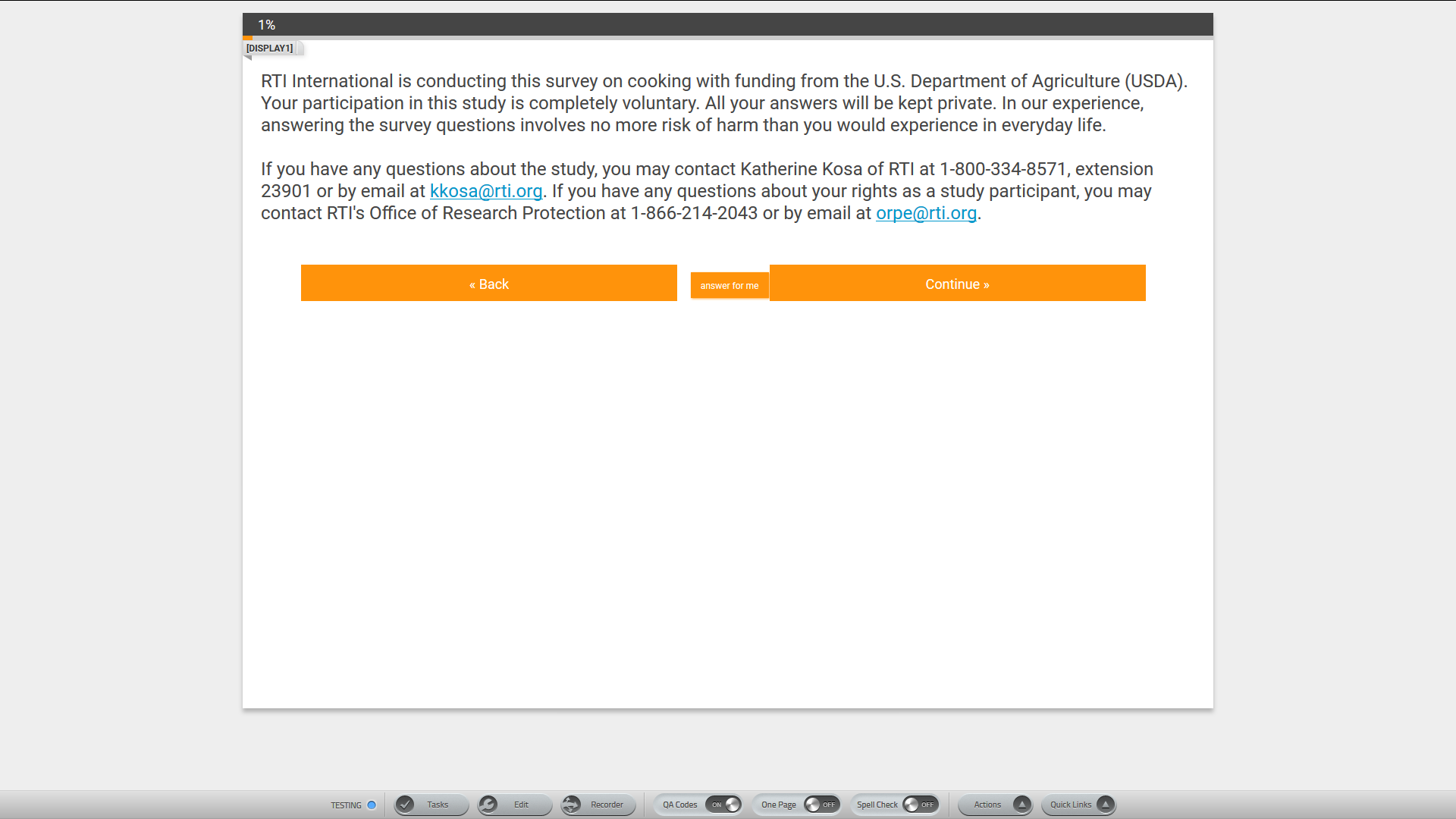



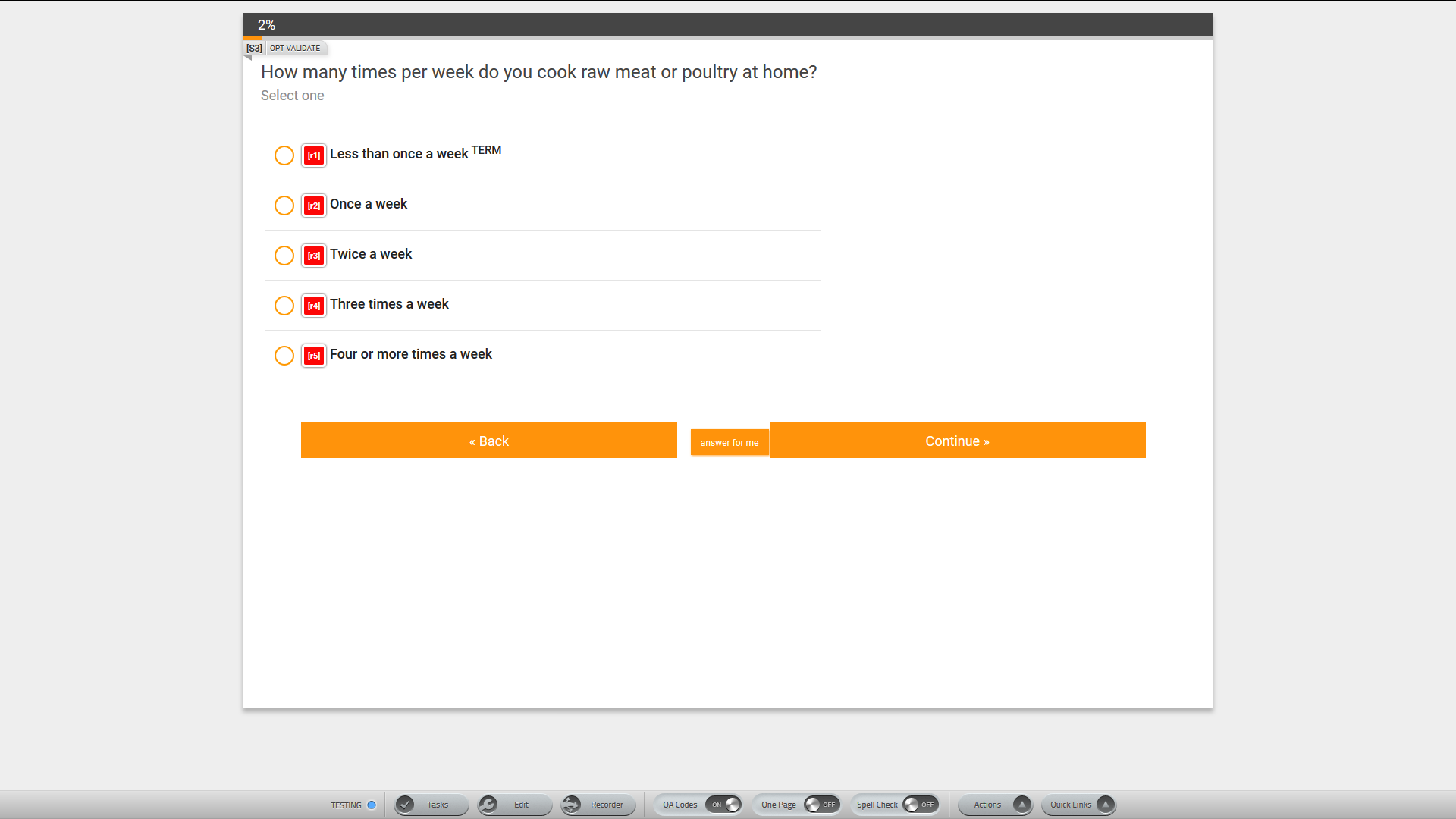



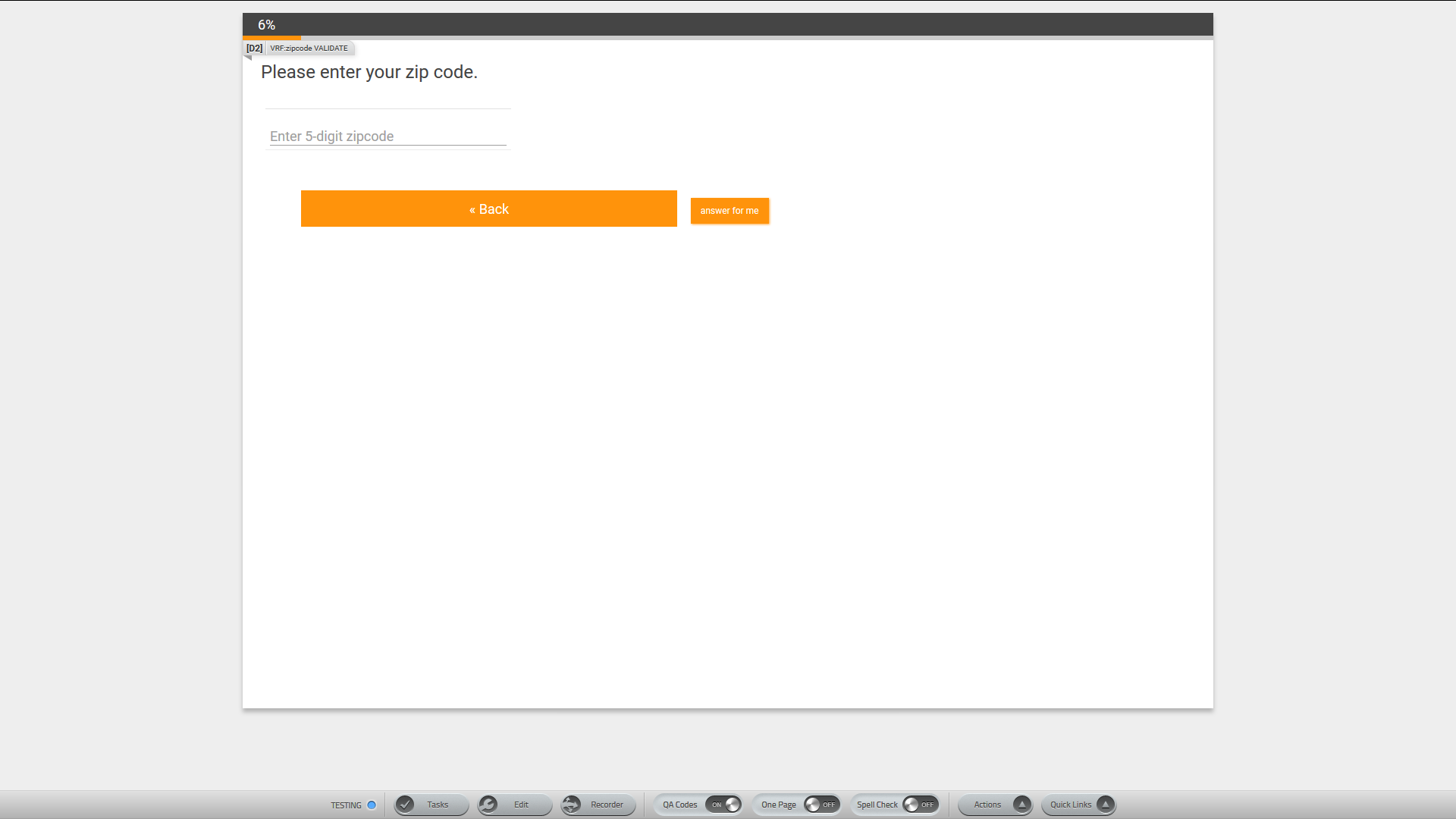











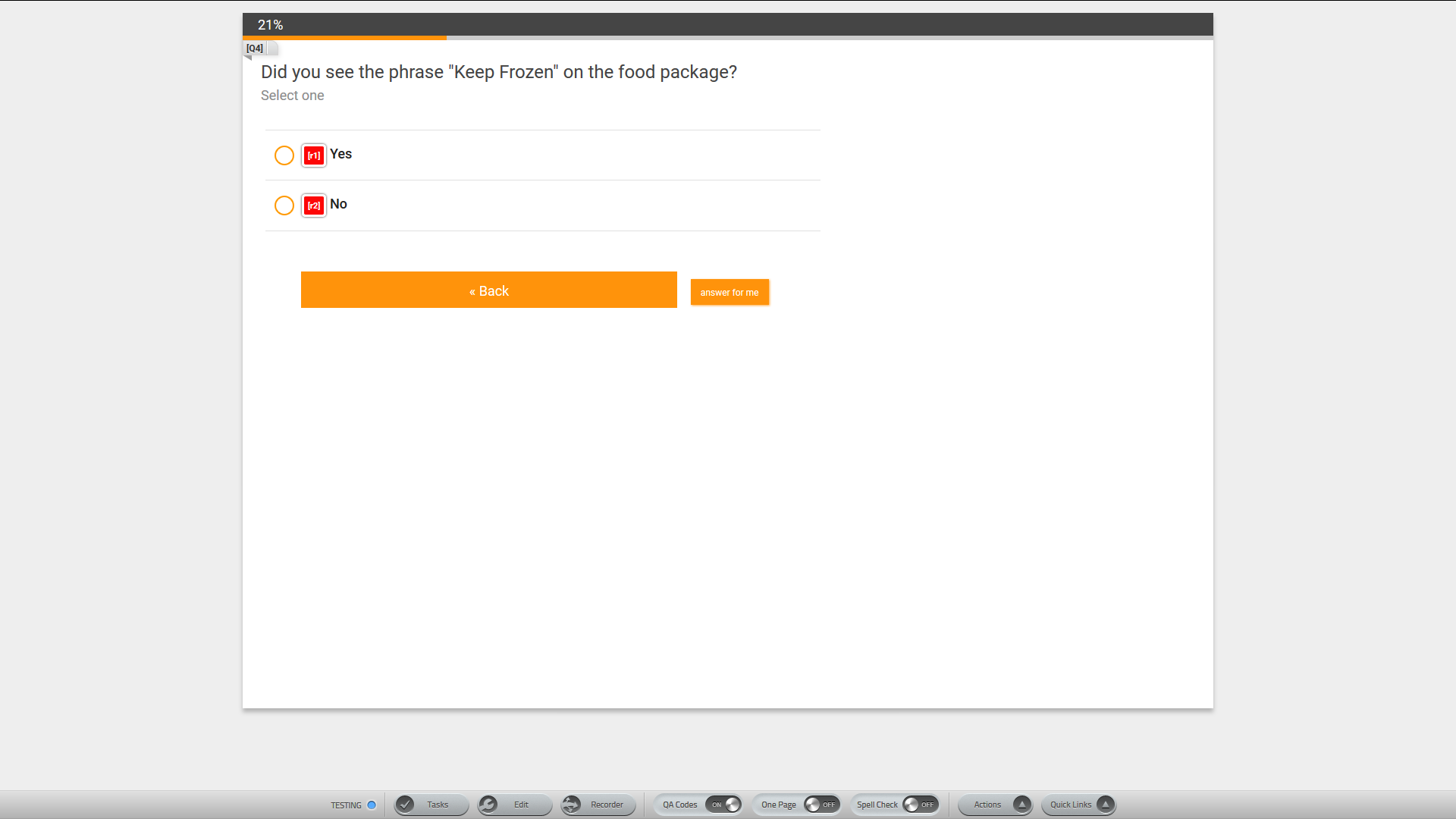







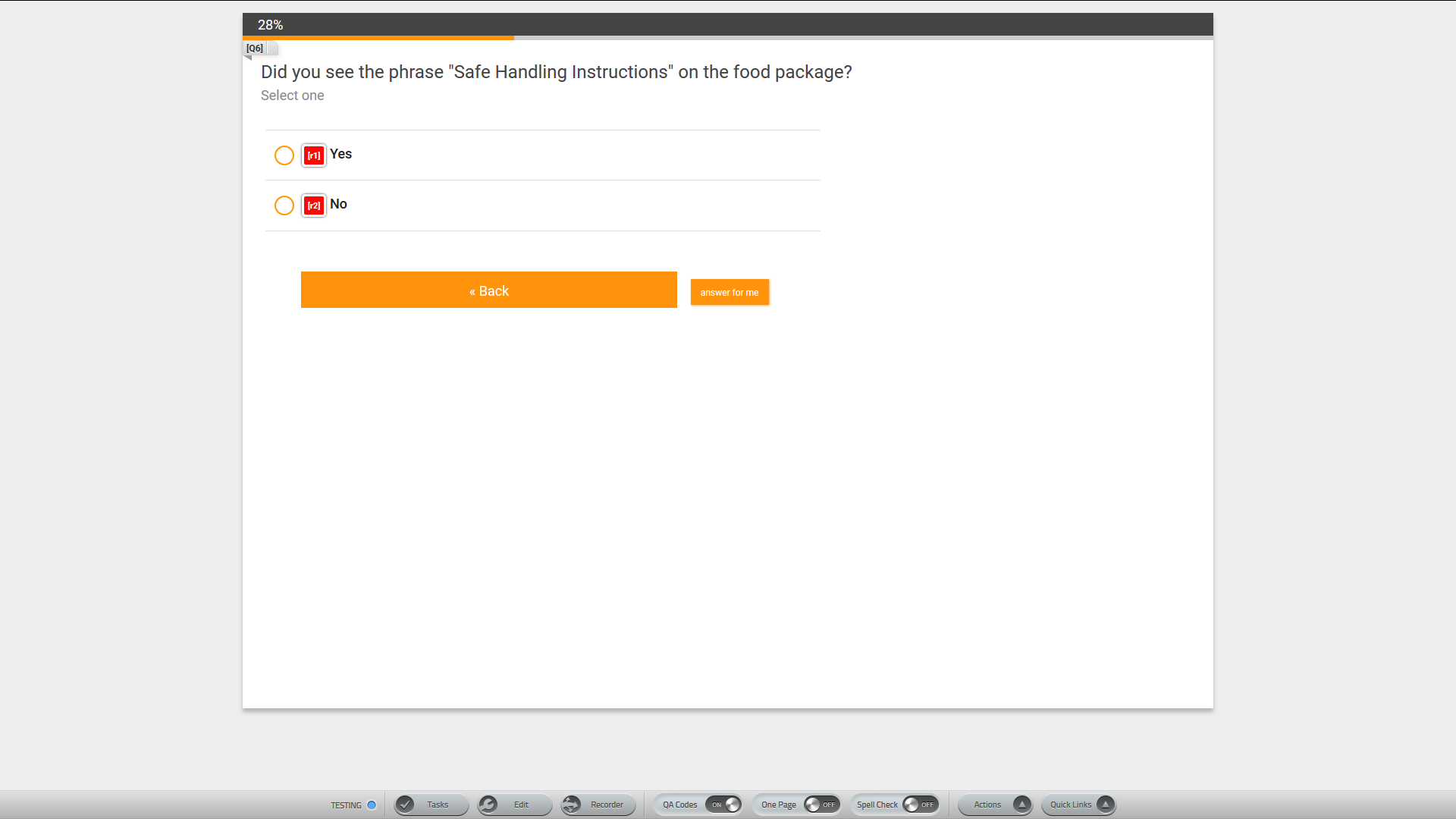

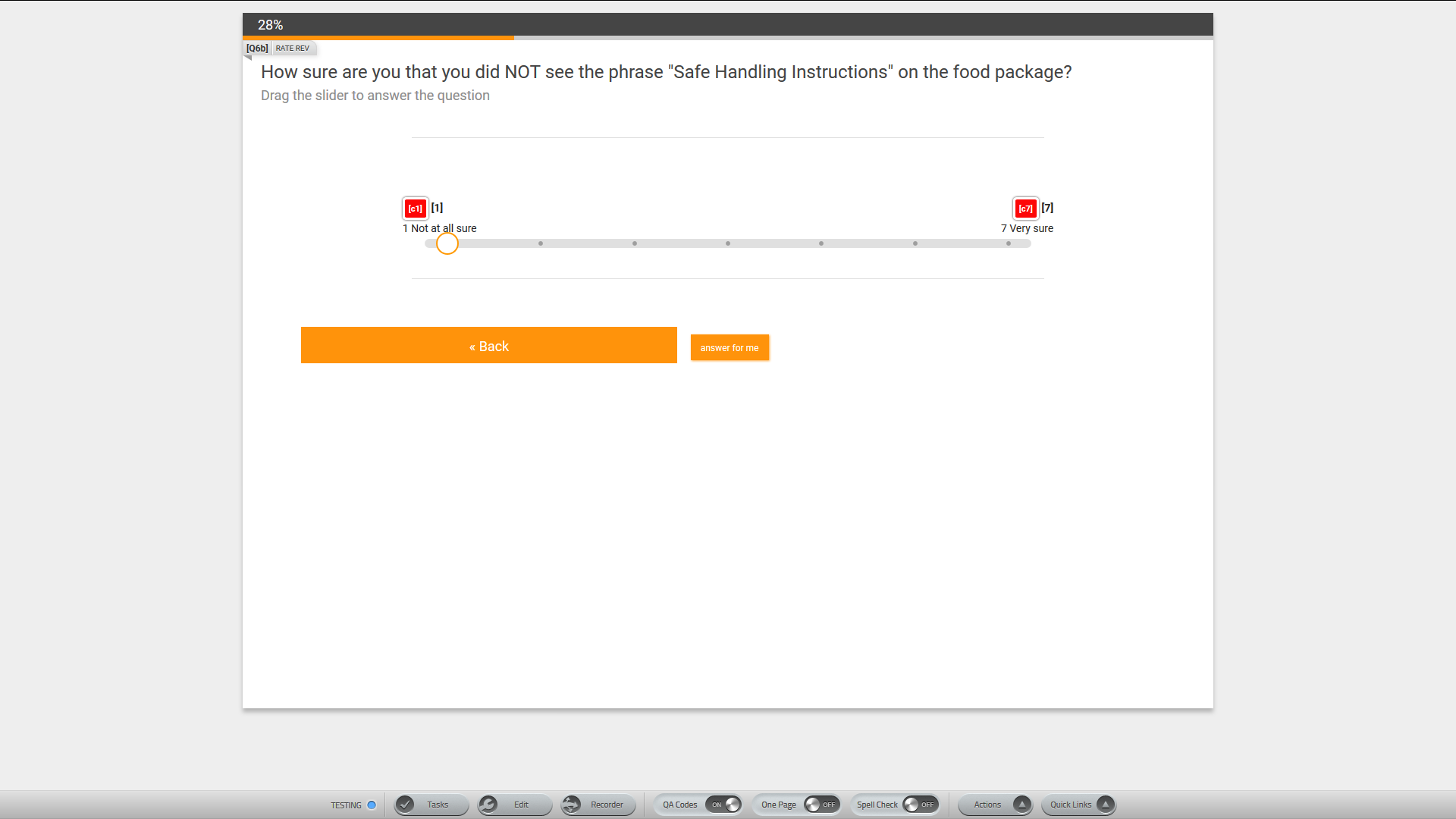














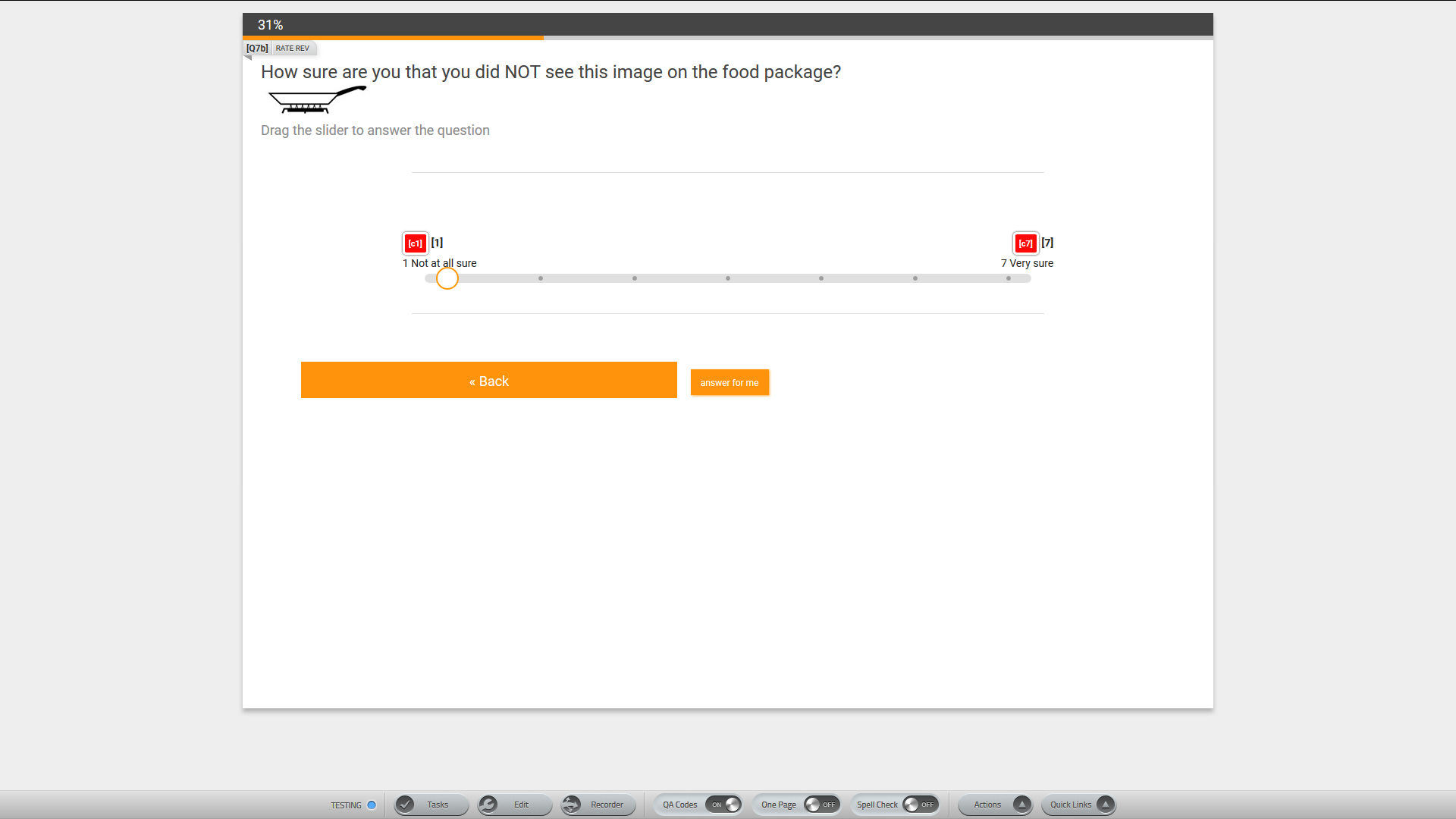


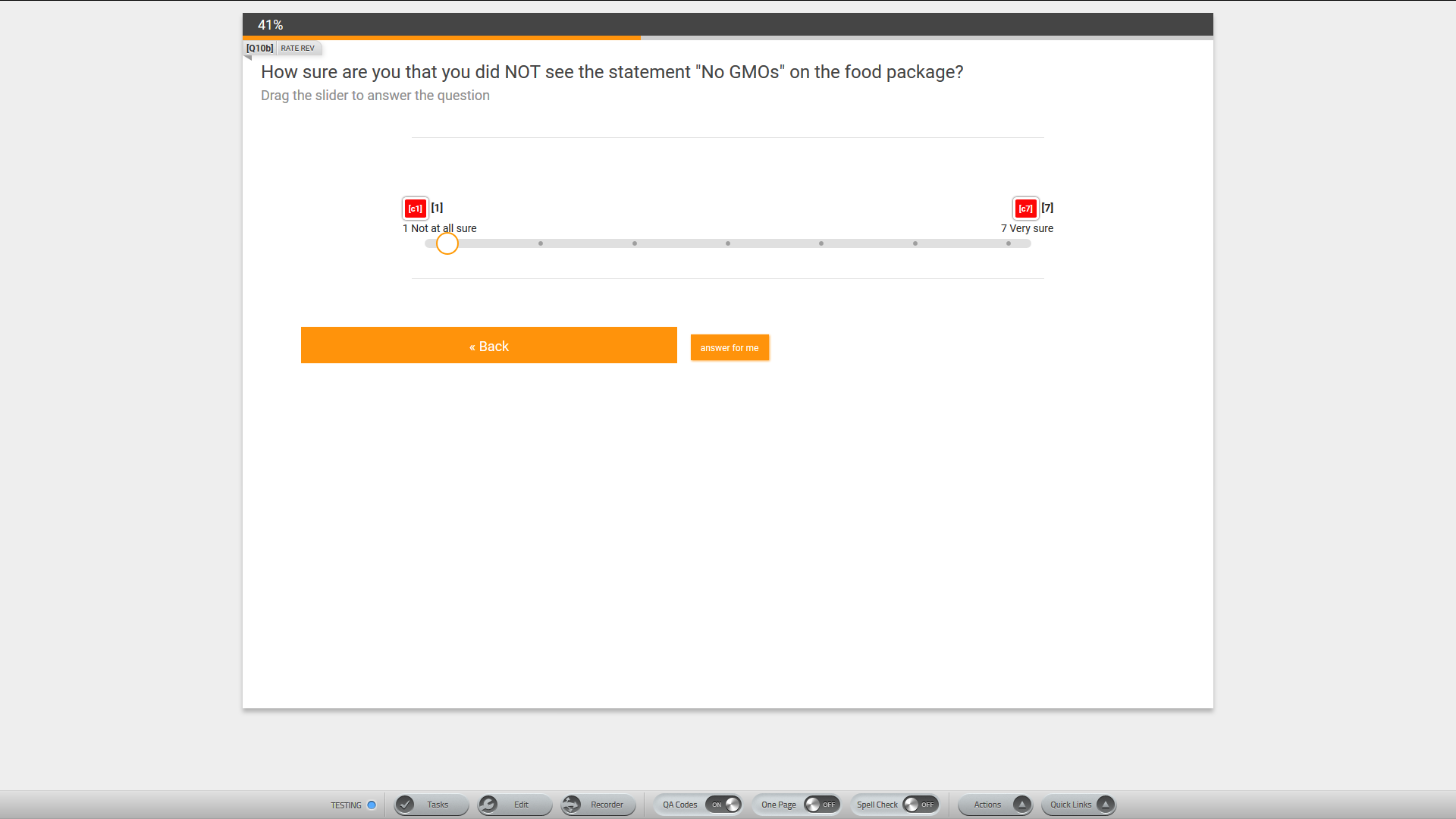
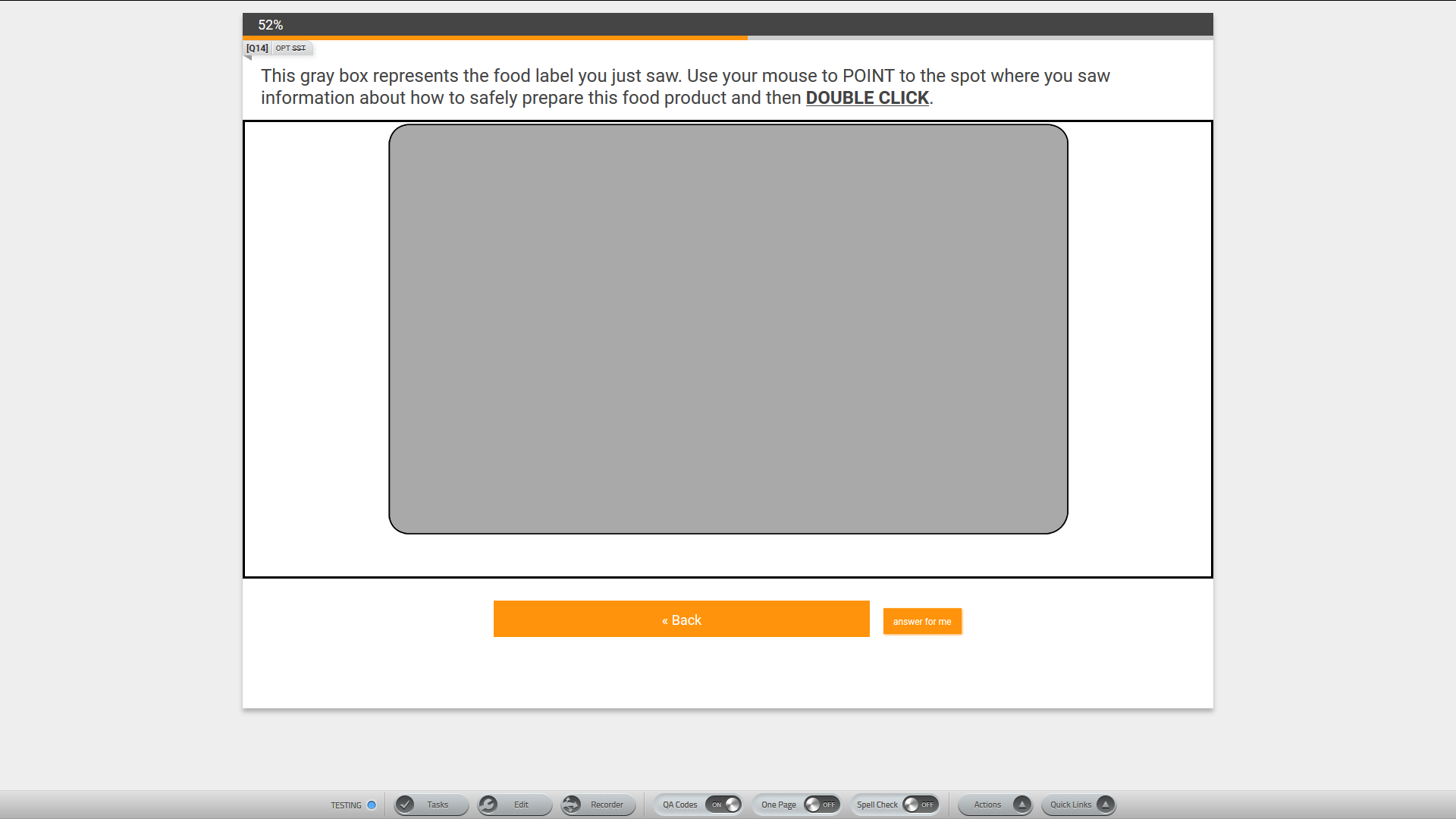



















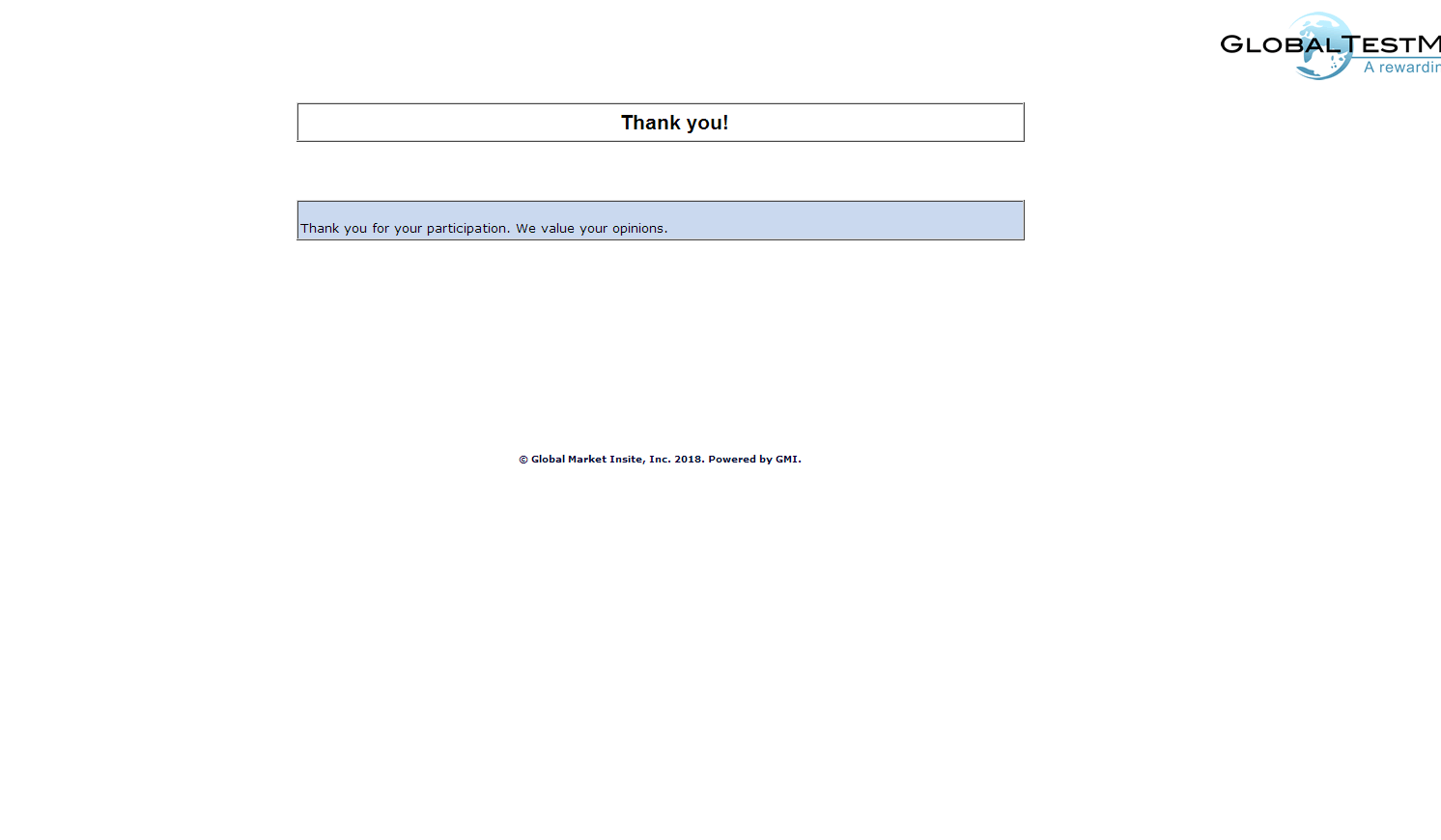
Appendix B4:
Screenshots
for Experimental Web-Based Study Instrument2—Spanish

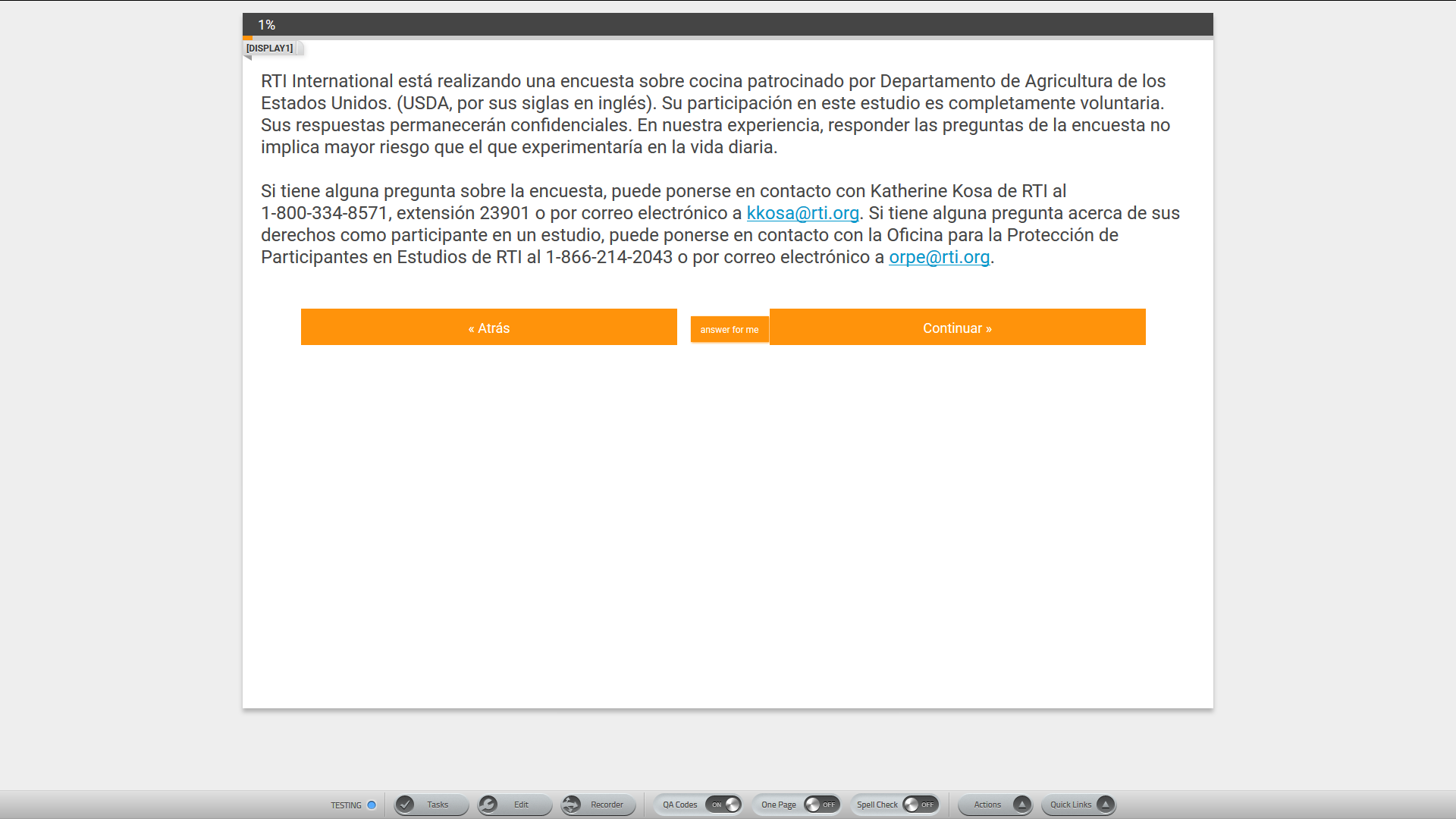








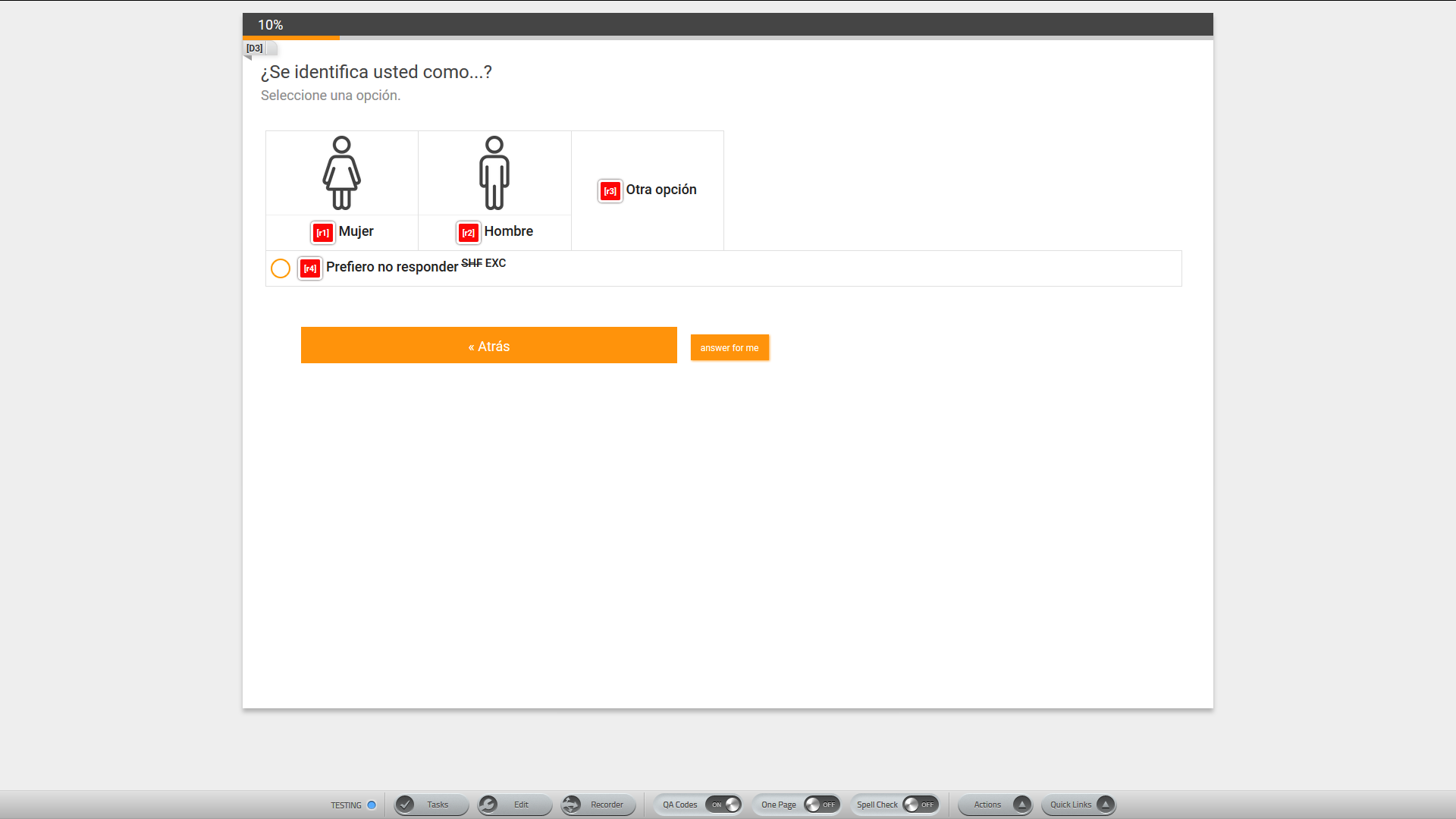













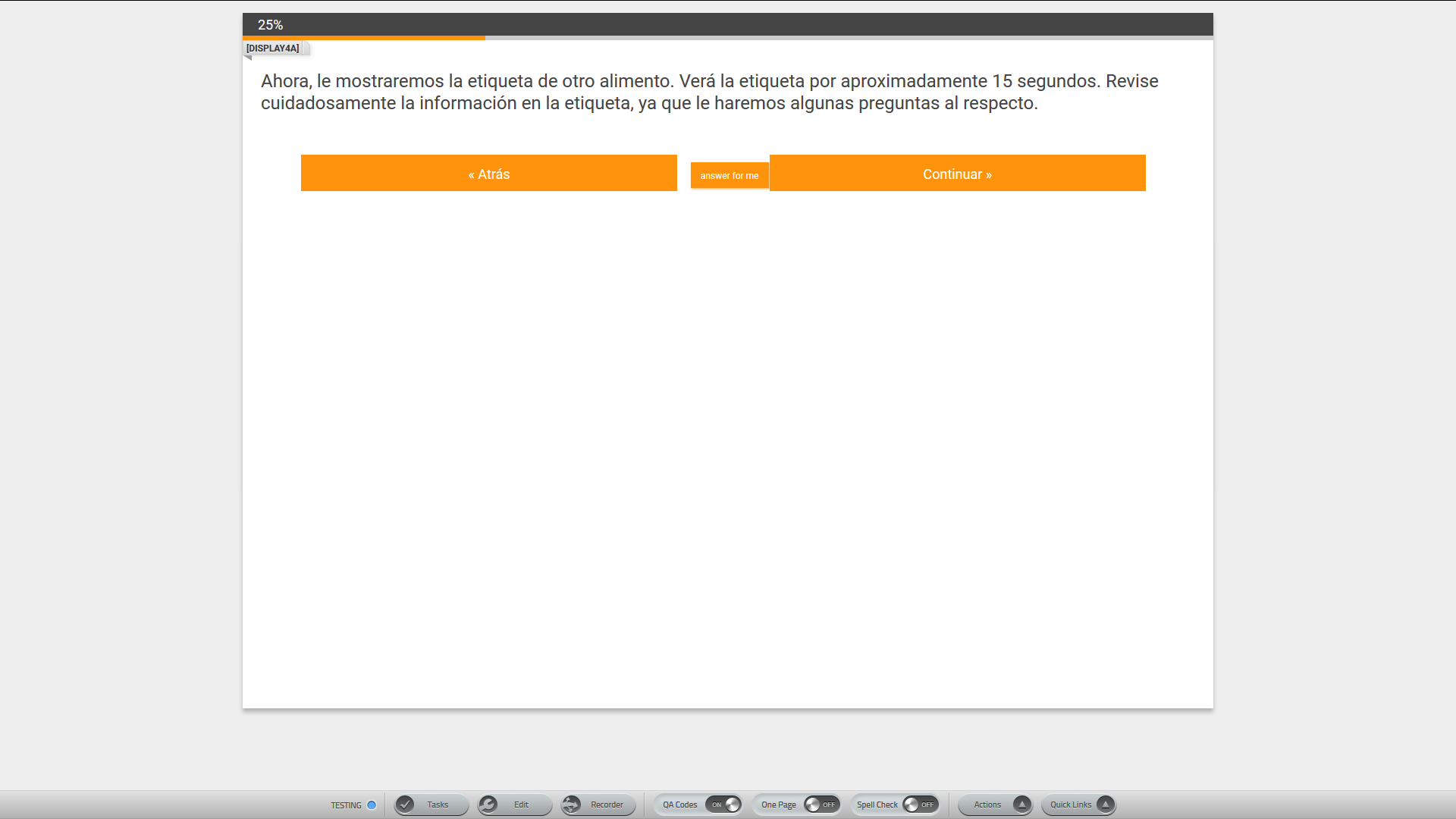


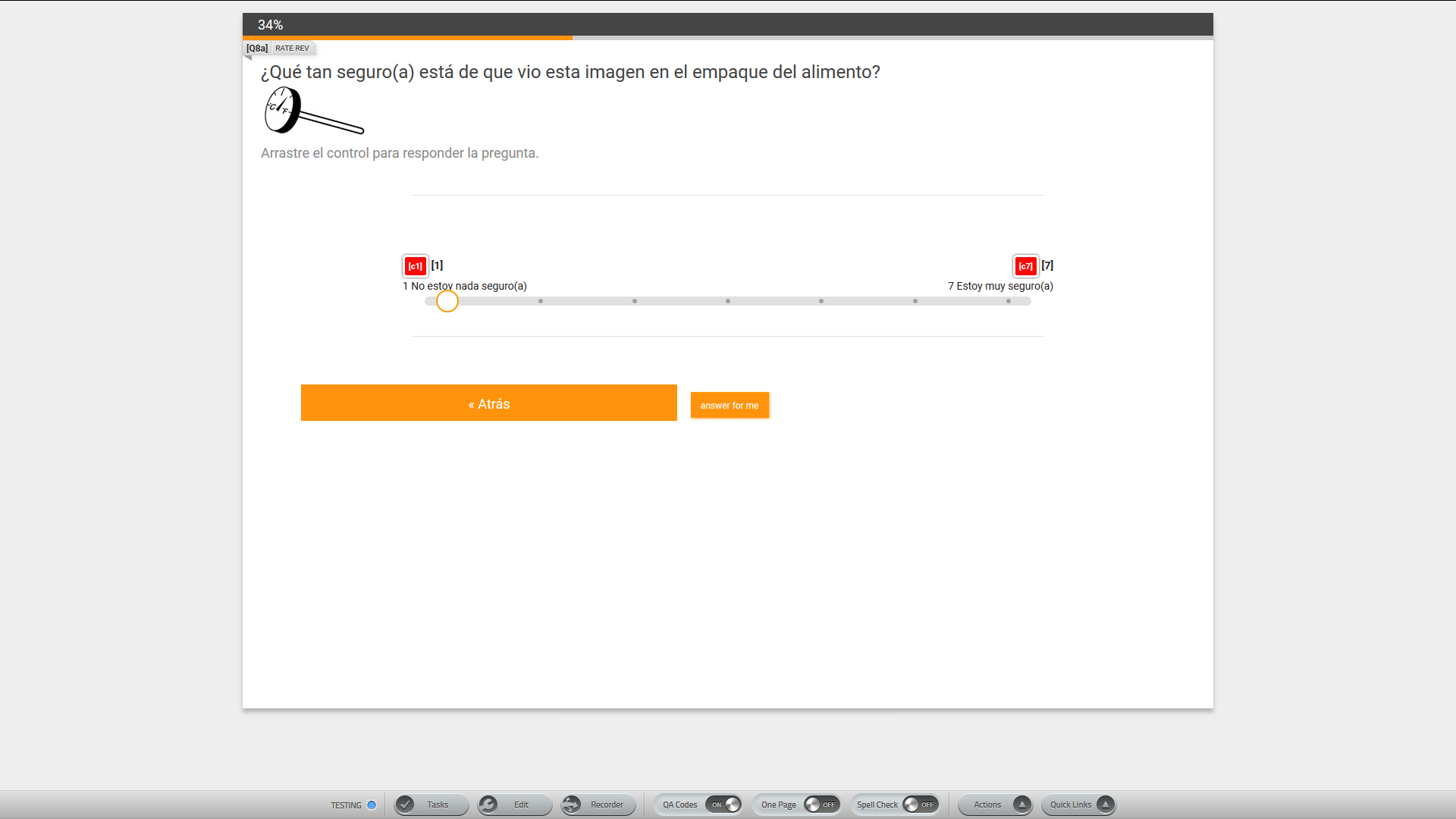






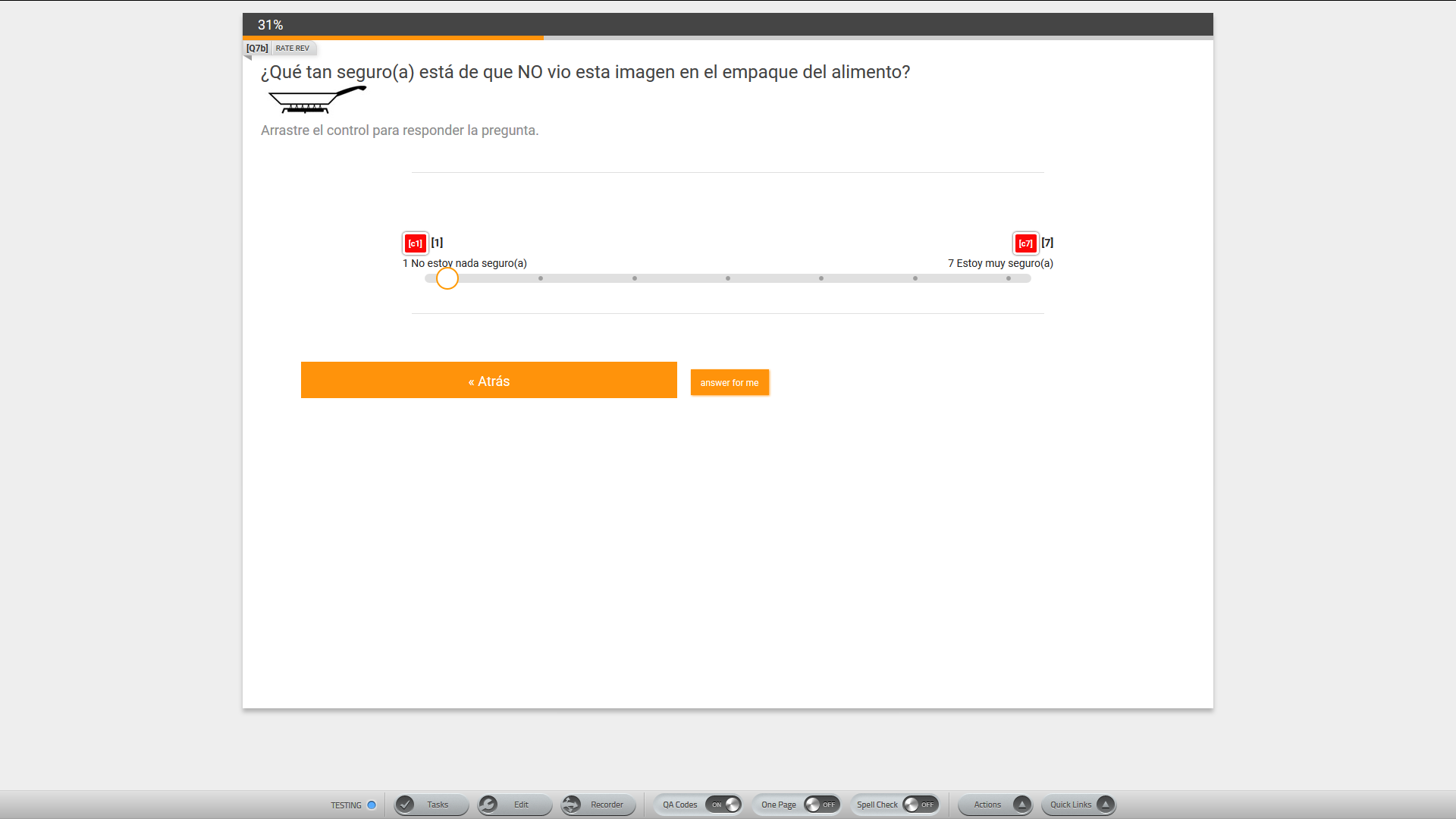




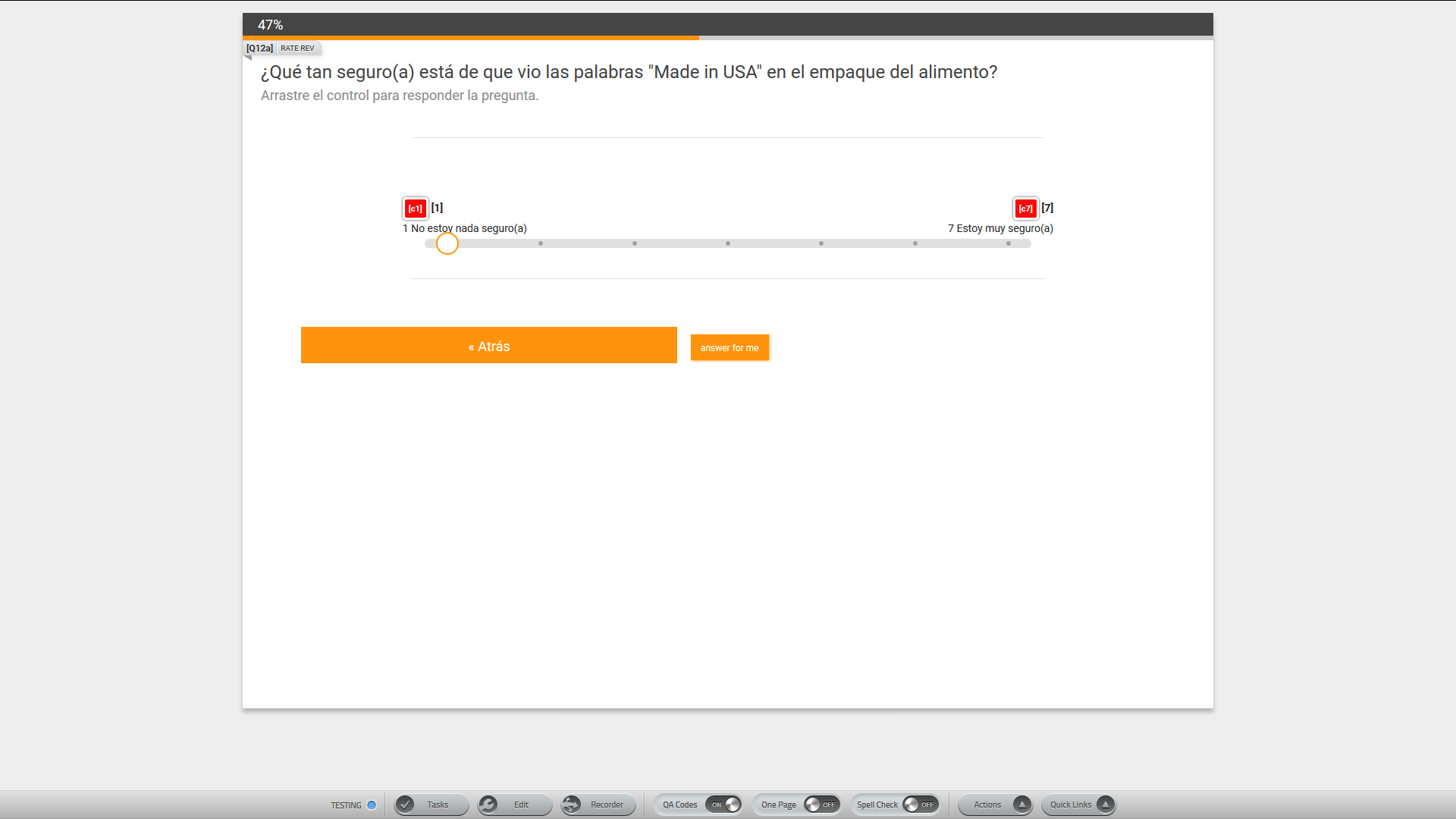




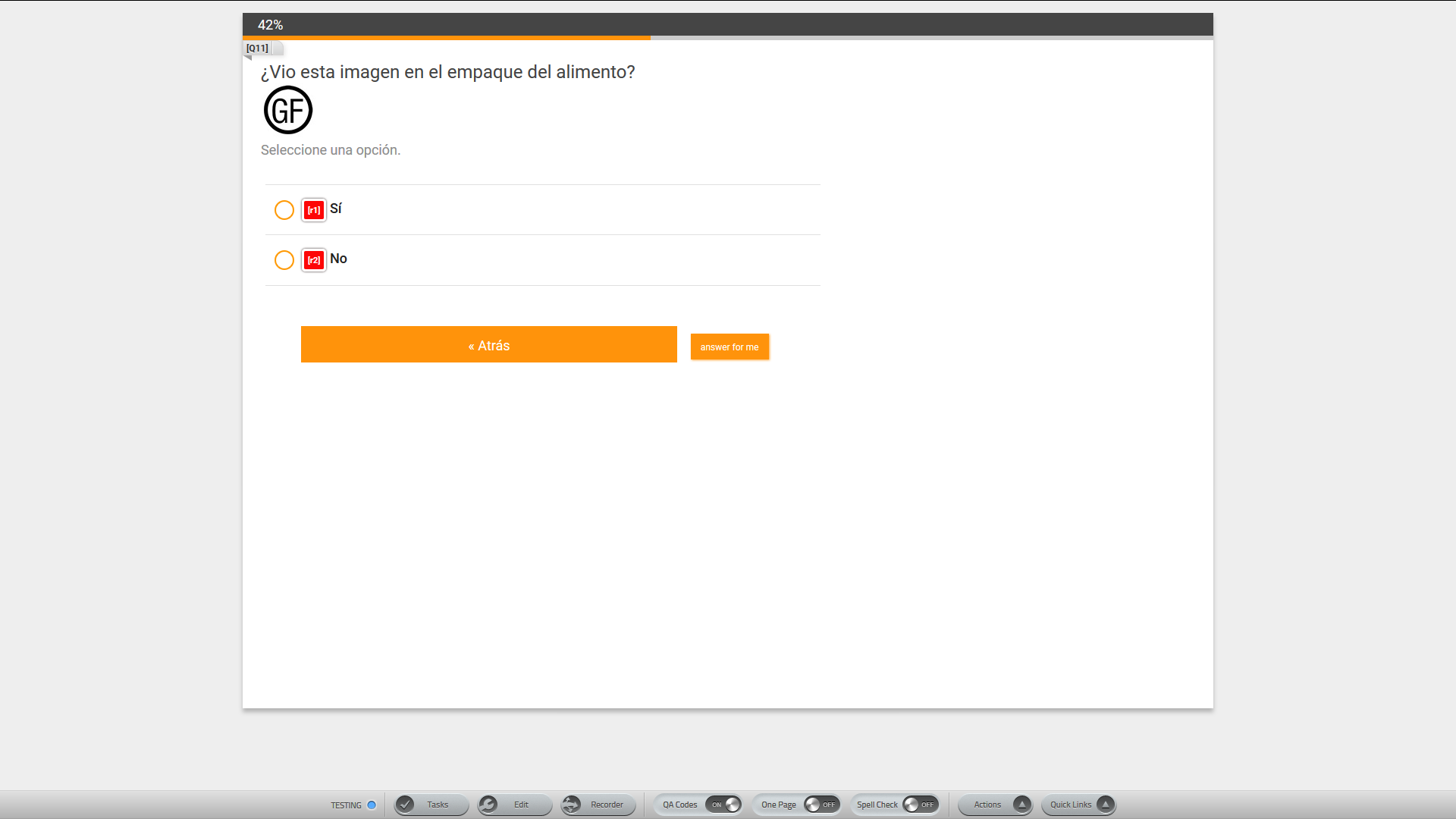






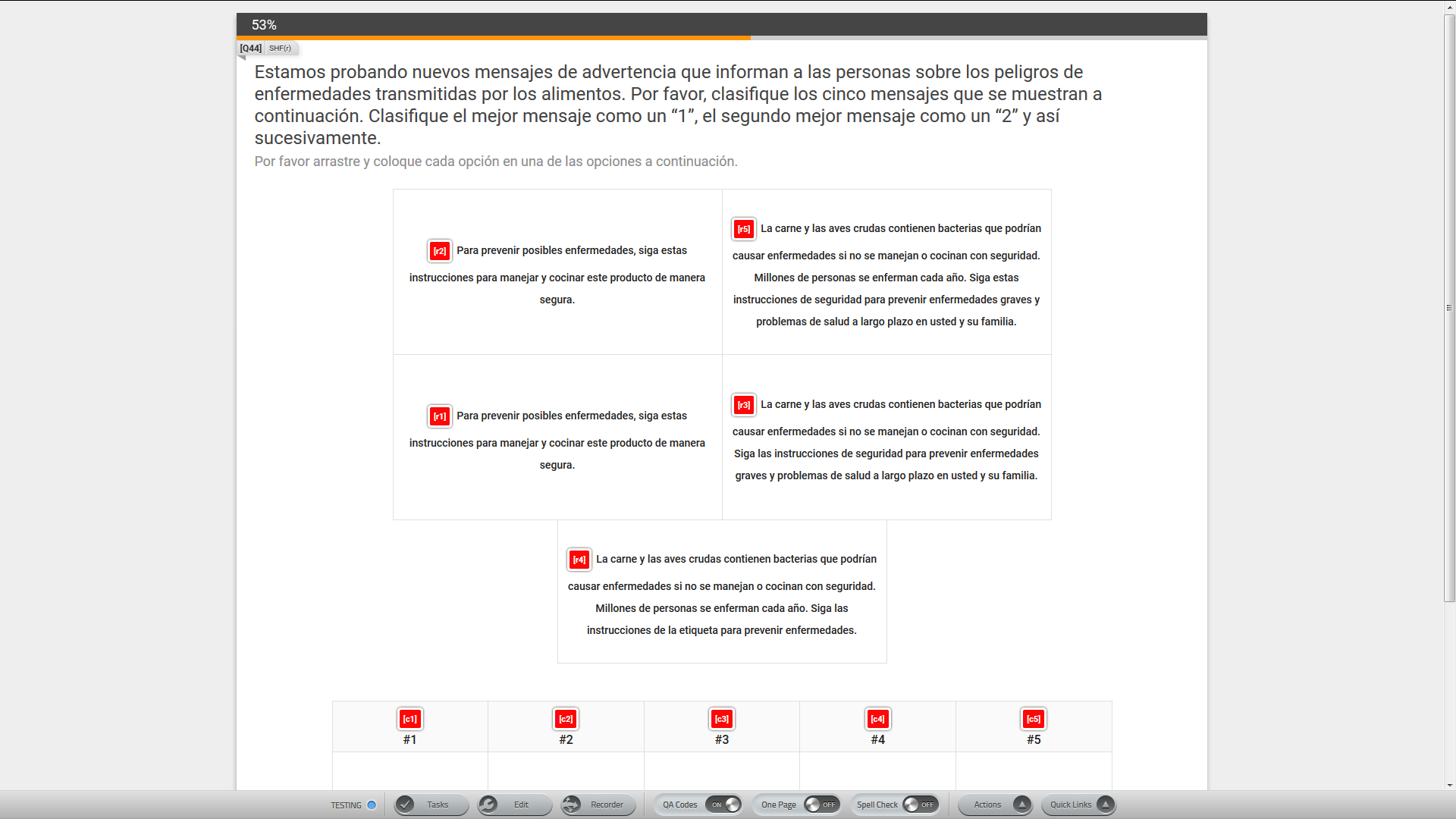
















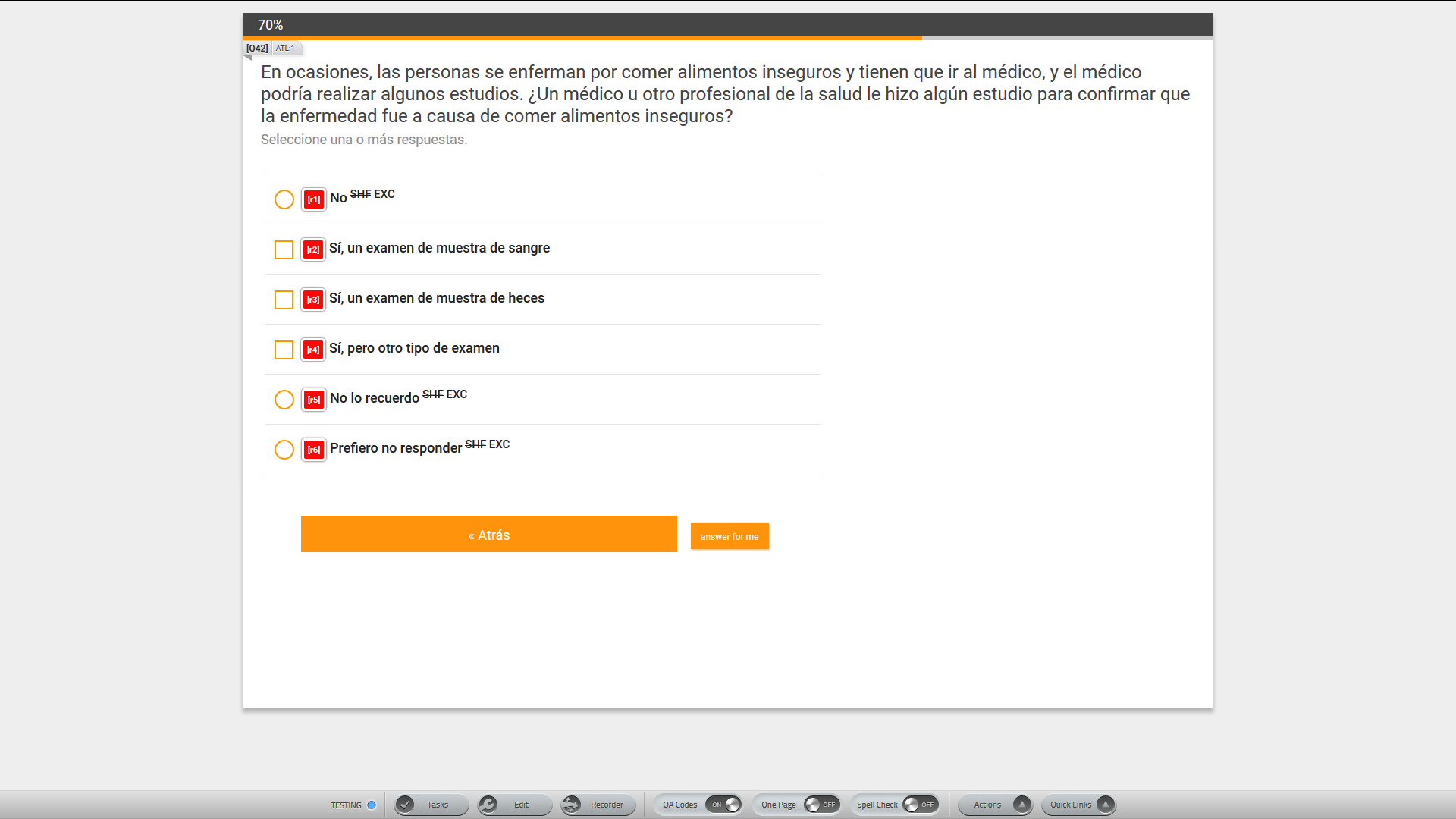

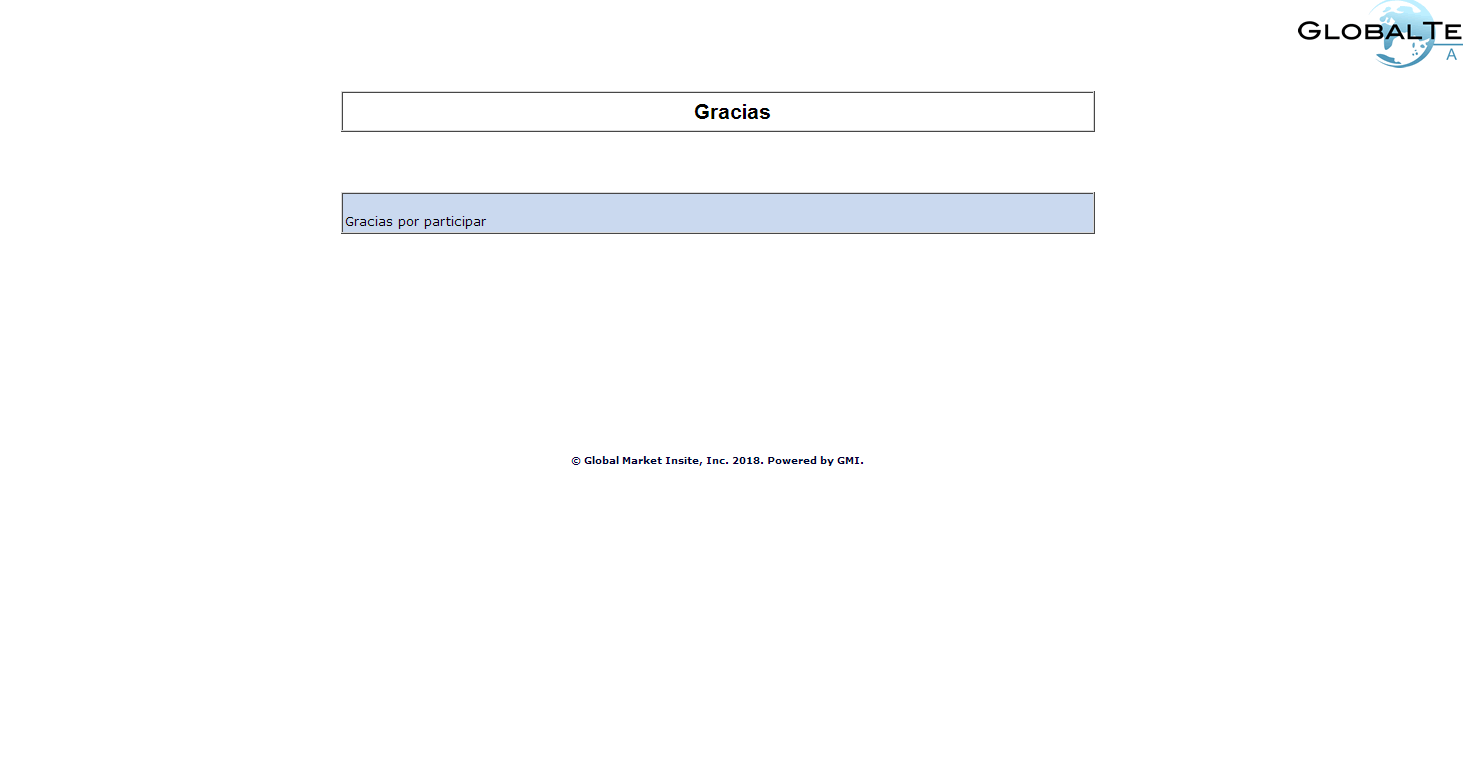
1 Because the Web survey is not currently live, the screenshots were provided in testing mode. Respondents will not see programming notes, like the numbered response items in red.
2 Because the Web survey is not currently live, the screenshots were provided in testing mode. Respondents will not see programming notes, like the numbered response items in red.
B-
| File Type | application/vnd.openxmlformats-officedocument.wordprocessingml.document |
| Author | Kosa, Katherine |
| File Modified | 0000-00-00 |
| File Created | 2021-01-15 |
© 2025 OMB.report | Privacy Policy